DAIRY ST R
Volume 24, No. 20

Volume 24, No. 20
NEWTON, Wis. – More than 40 years ago, Jim and Sandie Fitzgerald began fullling a dream to farm when they purchased their own place and put up a barn. It was the rst of several barns they would build throughout the years as their farm grew from a 60-cow dairy to a 1,200-cow dairy. In time, their children latched onto the same dream as four of the ve Fitzgerald children joined the operation to make the farm their career.
Today, the Fitzgeralds own the farm with their daughters, Kelly Goehring, Julie Maurer and Stacy Klotz, and their son, Nick Fitzgerald, with each holding 20% ownership in the farm.
FARLEY, Iowa – Looking at photos of Doug Simon and Dan Hansen’s dairy farm, one may nd it hard to believe the farm is not real but instead a diorama display on a 1/64th scale.
In fact, the farm is so realistic that it won the national championship in its class Nov. 5 at the 45th annual National Farm Toy Show hosted by the National Farm Toy Museum in Dyersville.

Although it was a thrill to be named champions, both Simon and Hansen said they had an excellent chance of winning that day.
“We were both condant that we were going to come home with a trophy,” Hansen said.
Simon agreed.
“It was the amount of time we put into it,” he said. “When
Kelly and her parents were partners in the business when they established Soaring Eagle Dairy in 1997. Stacy and Julie joined the operation in 2003, and Nick joined in 2011. Stacy’s husband, Jeremy, also works on the farm.
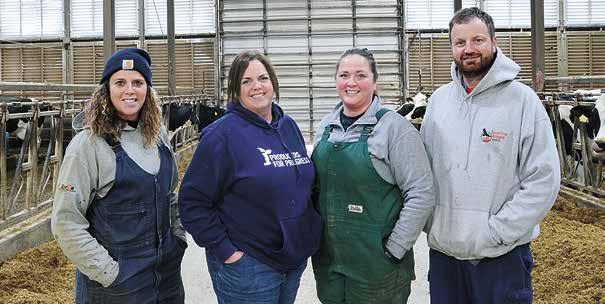
The family milks 1,150
cows and farms 2,200 acres near Newton with help from 20 full-time employees. Cows are milked three times a day in a double-16 parallel parlor. The farm’s rolling herd average is 30,856 pounds of milk, 4.2% butterfat and 3.2% protein.
Cows average 95 pounds of milk per day and maintain a somatic cell count under 150,000 on an annual basis. The Fitzgeralds ship their milk to Land O’Lakes.
Farming alongside their parents, the fourth generation is focused on continuous improve-

we were putting the whole display together, both of us kept saying that it was going to be really hard for somebody to beat this because it was pretty amazing seeing it all come together. What we ended up with was pretty cool.”
Simon and Hansen used weekends and any spare time for about a year and a half to create their masterpiece. Hansen worked from his home in Beaver Dam, Wisconsin, and Simon from his home in Farley.
“I built the equipment for the display,” Hansen said. “Doug did all the scenery and weathering stuff – putting manure in places, dirt and dust on the equipment and grass and gravel on the display board. We used each other’s talents within the hobby to do our own parts. Then a few parts we collaborated on and did together.”
Nothing on the display was simply purchased and placed. The farm equipment and some of the tractors were designed by Dan and then 3D printed by him.
A few tractors began as Ertl, a replica toy line, tractors but were sandblasted and deconstructed
down to the shell and then rebuilt and painted.
“Dairy cows in the barn are Ertl cows, but each one of them
has been custom painted (by Simon) with different markings because no two cows are alike,” Simon said. “Some of them are
December 10, 2022

ment of cows, crops, employees and the community, as is the generation before them.
“How do we get the next pound of milk or the next bushel of corn are questions we often like to ask ourselves,” Julie said. “How can we do better by the cow? The environment?”
Julie manages the parlor, is in charge of human resources and handles the Wisconsin Department of Natural Resources and Farm Service Agency regulations. Kelly and Stacy are the farm’s herd managers while Nick manages crops and does eldwork and maintenance with Jeremy. Julie’s daughter, Kelsey, also works on the farm. Jim and Sandie are semi-retired but active at Soaring Eagle Dairy.
“When there are six family members here on a daily basis, there are a lot of eyeballs on what’s going on,” Julie said.
One example of improvement was a tweak made to their milking system in 2016, which allowed the family to get more cows through the parlor. When
replicated off of show cows that my family shows competitively. The calves and the heifers, all the animals, were custom painted.”
For the contest, the display base had to be 8 feet by 8 feet, but materials used could be almost anything. Simon and Hansen were meticulous in their methods.
“Everything, even the littlest of things and accessories, we either weathered or detailed or made it custom,” Simon said.
Some of the feed in the display was made from actual feed.
“I would occasionally take a bag of distillers or soybean meal or corn gluten pellets, and Doug and I used a small coffee grinder to make it even ner,” Hansen said. “It still had the color and smell of real feed.”


They purchased additional materials from hobby stores.
“For the feed in the mangers and the alleyways, there’s a blended turf that they use in railroad hobbies that looks like a ground cover,” Simon said. “It
STACEY SMART/DAIRY STARwww.dairystar.com
• Online: 2834-6203
ISSN Print: 2834-619X
522 Sinclair Lewis Ave. Sauk Centre, MN 56378
Phone: 320-352-6303 Fax: 320-352-5647
General Manager/Editor
Mark Klaphake - mark.k@dairystar.com 320-352-6303 (ofce) 320-248-3196 (cell) 320-352-0062 (home)
Ad Composition - 320-352-6303
Nancy Powell • nancy.p@dairystar.com
Net U.S. cash farm income is forecast to be a record high $188 billion for 2022. That’s up 25.5% from 2021. Cash receipts for corn, soybeans, wheat and other crops are up 19%. Receipts from animal agriculture are expected to increase over 30% from last year.
The federal order Class III milk price was $21.01 per hundredweight. That’s 80 cents below October and $2.65 above November 2021. The Wisconsin all-milk price for October averaged $24.40 per hundredweight. That’s $2.30 above September and $4.70 more than October of last year.
Karen Knoblach
• karen.k@star-pub.com Annika Gunderson • annika@star-pub.com
Editorial Staff
Tiffany Klaphake - Assistant Editor 320-352-6303
• tiffany.k@dairystar.com
Maria Bichler - Assistant Editor maria.b@dairystar.com • 320-352-6303
Danielle Nauman - Staff Writer 608-487-1101 • danielle.n@dairystar.com
Stacey Smart - Staff Writer 262-442-6666 • stacey.s@dairystar.com
Abby Wiedmeyer - Staff Writer 608-487-4812 • abby.w@dairystar.com
Grace Jeurissen - Staff Writer 320-352-6303 • grace.j@star-pub.com
Jan Lefebvre - Staff Writer 320-290-5980 • jan.l@star-pub.com
Taylor Jerde - Staff Writer 507-403-1680 • taylor.j@star-pub.com

Consultant
Jerry Jennissen 320-346-2292
Main Ofce: 320-352-6303 Fax: 320-352-5647
Deadline is 5 p.m. of the Friday the week before publication Sales Manager - Joyce Frericks 320-352-6303 • joyce@dairystar.com
Mark Klaphake (Western MN) 320-352-6303 (ofce) 320-248-3196 (cell)
Laura Seljan (National Advertising, SE MN) 507-250-2217 • fax: 507-634-4413 laura.s@dairystar.com
Jerry Nelson (SW MN, NW Iowa, South Dakota) 605-690-6260 • jerry.n@dairystar.com
Mike Schafer (Central, South Central MN) 320-894-7825 • mike.s@dairystar.com
Amanda Hoeer (Eastern Iowa, Southwest Wisconsin) 320-250-2884 • amanda.h@dairystar.com
Megan Stuessel (Western Wisconsin) 608-387-1202 • megan.s@dairystar.com
Kati Kindschuh (Northeast WI and Upper MI) 920-979-5284 • kati.k@dairystar.com
Julia Mullenbach (Southeast MN and Northeast IA) 507-438-7739 • julia.m@star-pub.com
Bob Leukam (Northern MN, East Central MN) 320-260-1248 (cell) bob.l@star-pub.com
The deadline for news and advertising in the Dairy Star is 5 p.m. Friday the week before publication.
One year subscription $40.00, outside the U.S. $200.00. Send check along with mailing address to Dairy Star, 522 Sinclair Lewis Ave., Sauk Centre, MN 56378.
Our ad takers have no authority to bind this newspaper and only publication of an advertisement shall constitute nal acceptance of the advertiser's order.
Letters and articles of opinion are welcomed. Letters must be signed and include address and phone number. We reserve the right to edit lengthy letters. The views and opinions expressed by Dairy Star columnists and writers are not necessarily those of the Dairy Star / Star Publications LLC.
The Dairy Star is published semi-monthly by Star Publications LLC, 522 Sinclair Lewis Ave., Sauk Centre, MN 56378-1246. Periodicals Postage Paid at Sauk Centre, MN and additional mailing ofces.
POSTMASTER: Send address changes to Dairy Star, 522 Sinclair Lewis Ave., Sauk Centre, MN 56378-1246.
In the words of President Joe Biden, Congress’ action on the rail contract will spare the country “a Christmas catastrophe in our grocery stores, our workplaces and in our communities.” The House and Senate took action to force unions to accept a tentative contract agreement that was adopted in September. Biden later signed the legislation. The ve-year contract gives union railroad workers a 24% bump in wages but does not address the issue of paid sick leave.
The Republicans have a slim majority in the House and a very tight margin is in the Democrat’s favor in the Senate. Compeer Financial chief mission and marketing ofcer John Monson said that will inuence the farm bill debate. “I don’t sense that given the dynamics in place right now, that we’re going to see a
major shift in policy perspective,” Monson told Red River Farm Network. “It just seems to me that the path of least resistance is more of an extension of the current farm bill at least for a year, if not longer.” Monson said there will be different dynamics at play during the upcoming session. “The nutrition title will cost 85% of this next farm bill of $1.3 trillion. That’s going to be a big task.”

The World Trade Organization’s agriculture committee is working on a strategy to address hunger, especially in the least developed countries. Future discussions will center on market access, nancing food purchases and the strength of farm production worldwide. Specic policies were reviewed, including the U.S. Ination Reduction Act, the European Union’s new Common Agricultural Policy and Canada’s dairy supply/management program. Another meeting is planned in early December to continue the discussion.




In an update on John Deere’s quarterly earnings,
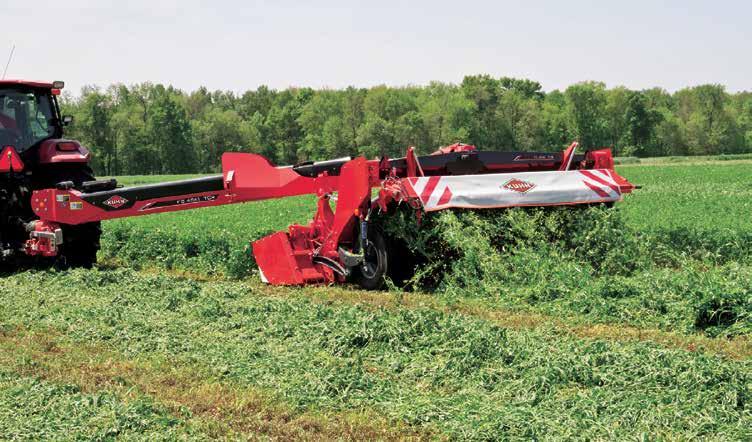




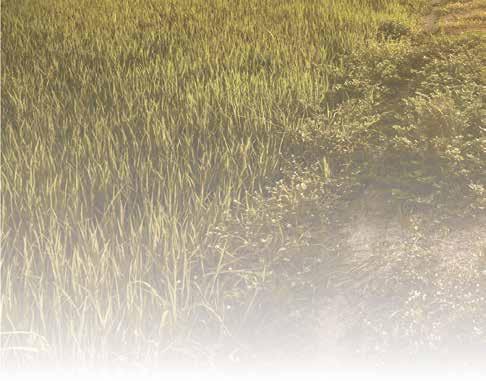




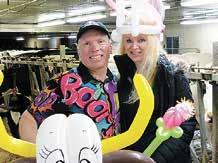
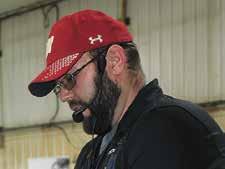
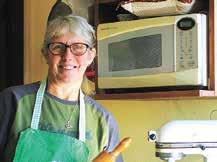












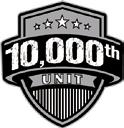











Reuters reported farm equipment and combines are virtually sold out for 2023. StoneX chief commodity economist Arlan Suderman said the high commodity prices in recent years have driven up demand. “Unfortunately, the same issues keeping us from getting new cars is also happening in the equipment industry,” Suderman said. The computer chip shortage is the missing link. “So much of our equipment is reliant on chips, and there is still a shortage,” he said. “The ability to manufacture and get products distributed has led to some long waiting lists for equipment.”


The National Milk Producers Federation is asking Congress to protect the domestic production of infant formula. When supplies tightened earlier this year, tariff waivers were granted to bring more baby formula into the United States. NMPF said the situation has improved and the preferential tariff benets should be allowed to expire at the end of the year.
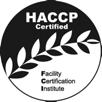
Federal Reserve Board chairman Jerome Powell signaled the central bank is on track to raise interest rates by a half a percentage point at its next meeting. During a speech Wednesday, Powell said it would make sense to slow rate increases to give the economy time to adjust to previous rate hikes. A 75 basis point interest rate hike was seen for four straight months.
According to U.S. Department of Agriculture’s report on farm labor, farms in the Lake Region paid their hired workers an average of $18.83 per hour. That’s an increase of $2.62 per hour from one year ago. The Lake Region is made up of Wisconsin, Minnesota and Michigan.
New Jersey Sen. Cory Booker has introduced a bill targeting largescale livestock operations. The pro-
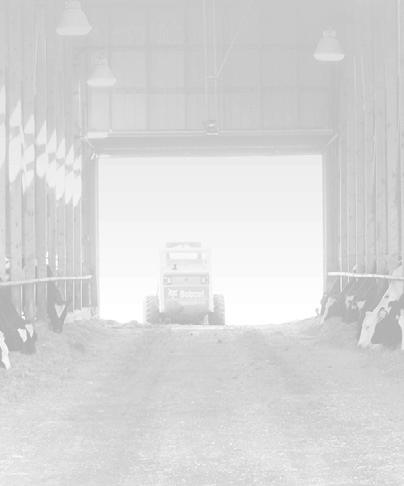




posal would require packers, processors and farmers to register their businesses with USDA, submit a disaster preparedness plan and pay for disaster mitigation. The bill also calls for more humane treatment of downed animals or those being depopulated due to a disease. Booker is a member of the Senate Agriculture Committee and has proposed similar bills in the past.


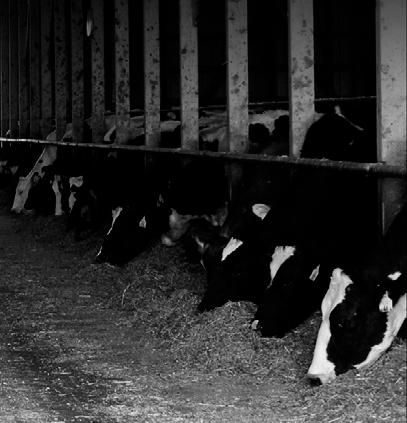
Former WFBF president passes

Former Wisconsin Farm Bureau president Donald Haldeman, 85, has passed away. Haldeman was elected in 1971 and served 20 years. Haldeman was a dairy farmer near Norwalk, Wisconsin.
Selz-Pralle honored


Dairy Girl Network presented its rst-ever Leading Impact Award to Pam Selz-Pralle of Humbird, Wisconsin. Selz-Pralle and her husband, Scott, have been recognized as Holstein USA Outstanding Young Breeders and Wisconsin Jaycee Outstanding Young Dairymen, and Pam has been honored as a Wisconsin Master Agriculturalist.
During the National Association of Farm Broadcasting Annual Meeting, Madison, Wisconsin-based farm broadcaster Pam Jahnke was inducted into the National Farm Broadcasting Hall of Fame. Jahnke leads the Midwest Farm Report.
Germany is credited with starting the tradition of putting up a Christmas tree. That answers our last trivia question. For this week’s trivia, how much eggnog is consumed by Americans each Christmas season? We will have the answer in the next edition of Dairy Star.
Don Wick is owner/broadcaster for the Red River Farm Network, based in Grand Forks, North Dakota. Wick has been recognized as the National Farm Broadcaster of the Year and served as president of the National Association of Farm Broadcasting. Don and his wife, Kolleen, have two adult sons, Tony and Sam, and ve grandchildren, Aiden, Piper, Adrienne, Aurora and Sterling.
had the color variation of cattle feed. Within the hobby world, there’s a vast variety of products available to buy for making a display.”


Both Simon and Hansen have competed diorama display contests separately, but this was the rst Simon-Hansen collaboration. The partnership all began with a text.
“Doug sent me a text one day and asked if I had ever wanted to build a display for the national competition,” Hansen said. “I was hauling manure at the time, and I said yes. That was about a year and a half ago.”
Simon and Hansen grew up going to farm toy shows and became friends after meeting at one of them.
Simon now works for a trucking company, but he helps on a dairy farm, Farnear Holsteins, near Farley that is owned by his two uncles. The robotic dairy barn in the display is loosely based on their barn.
“My dad was a milk hauler for 35 years, so I grew up riding with him in the milk truck, going to all these different farms,” Simon said. “My mom worked for Ertl Toys nearby in Dyersville for a number of years. For birthdays or holidays, I would get toy tractors or farm and country playsets with everything you need to create a farm scene. That would get my imagination going.”
Because Dyersville was only a few miles away, Simon also had easy access to the national toy shows.
“I saw all the display contests, and I got ideas,” he said.



Simon started creating scenes of his own. It seems his whole childhood was a rehearsal for building diorama displays.
Meanwhile, Hansen was growing up in Beaver Dam, Wisconsin, with his own interest in farm toys and replicas being honed.


“I grew up on the farm here at home, but the majority of my life I’ve worked at Brossard Dairy, a 450-cow dairy down the road from me,” Hansen said. “This past year I started hauling cattle feed, mainly in the Midwest, so I’ve always had a connection to agriculture and farming since I was a little kid.”
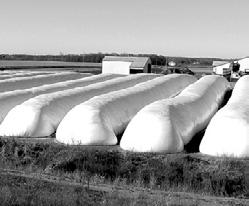
Hansen’s dad owned a small equipment repair business and worked on tractors, various equipment and semis for farmers as well as hauled grain and hay .



“I’m more equipment focused from seeing tractors and equipment coming in
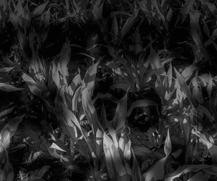


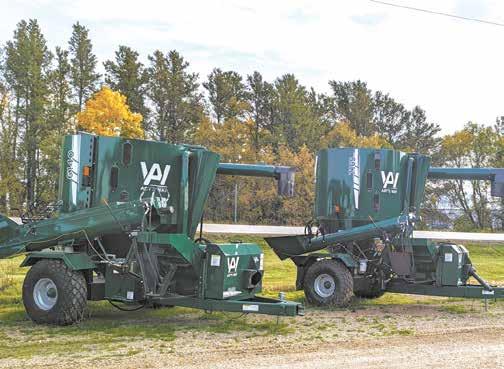


and out of the yard,” Hansen said. “On top of that, I never had video games. It was always just toy tractors.”
His parents liked the farm toy shows and brought him every year to local ones as well as the national show in Iowa.
“As I grew older, I got more into the hobby and wanted to change things,” Hansen said. “I’d take a tractor out of the package and, for example, if it didn’t have duals on it and I wanted more tires on it, I just glued more tires to it. From there, it progressed. If I wanted something that Ertl didn’t make, I would try to build it myself.”
As Simon and Hansen worked on their display, they received help from friends in the hobby world and beyond. Some helped build a few pieces, one friend loaned them shop space for putting the whole display together and another let them use his enclosed wagon to haul the main part of the display from the shop to the competition.
“We’ve had a few different people playing a hand in this,” Hansen said.

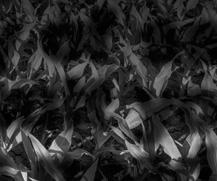



Family and friends came to the competition to cheer them on.
Simon and Hansen spent ve hours reassembling their display Nov. 4 for the judging that would take place by a panel later that day. They were competing against three other displays in their class. There were two other classes, a 1/16th class and a youth class.
The winners were not announced until Saturday, but the wait was worth it for Simon and Hansen as they heard themselves declared national champions.
“Doug and I looked at each other and gave each other a hug and a really hard high ve,” Hansen said.
Both felt a sense of accomplishment.
“We had been working on it for so long, basically calling each other about it or life in general every day,” Simon said. “It was pretty rewarding to see it come full circle.”
Hansen agreed.
“For two guys like us, who have gone to shows as long as we have and have seen so many winning displays, to actually leave with a win was awesome,” he said.
Simon and Hansen said they will now take a break from building displays, but neither is ready to say goodbye to the hobby.
“We’ve got some ideas in the works,” Simon said.
they switched from using dip and towels to using a scrubber to prep cows, the Fitzgeralds found that cows let down their milk more quickly. Faster milk outputs created a need to increase the capacity of the lines and meters to move milk away at a higher speed. Changing pipes allowed for the extra milk ow, and now the farm averages around 32 pounds of milk per cow per milking in under four minutes.
The farm does no till and plants cover crops on about 50% of the land and has also created buffer strips and grassed waterways to offer protection from nutrient contamination. A conversion to dry corn four years ago led to the Fitzgeralds building a grain drying and storage facility.

“Prior to that, we were feeding highmoisture corn, and I felt we lagged in components,” Julie said. “The drying center really allowed us to kick up our butterfat and protein levels.”
The Fitzgeralds have remained focused on their goals as they built, expanded and improved their operation. Through stages of growth and modernization, they grew at a pace compatible with their efcient and protable mindset.


It was in 1980 that Jim ventured out on his own after farming with his father and brothers for 14 years. He built a 60cow tiestall barn on the farm where he and Sandie raised a family. Prior to the expansion in 1997, the Fitzgeralds were milking 90 cows three times a day. Taking the farm in a direction of growth and prosperity for the future, they built a 400cow freestall barn and double-12 parallel parlor and grew to 500 cows. Two years later, a transition barn was added.
By 2000, the family was milking 650 cows and an addition was made to the freestall barn. Four years later, they added onto the barn once again when cow numbers reached 850. The transition barn was also expanded in 2004, adding 100 free stalls and a dedicated maternity area. In 2005, a second freestall barn was built, and the parlor was expanded to a dou-
ble-16, which allowed the milking herd to grow to 1,100. In 2016 and in 2020, two more barn additions were completed.

“We’ve been growing internally since 2000,” Stacy said. “That is the last time we purchased a cow, and we sell extra cows yearly.”
Cow comfort is critical to the Fitzgeralds who have invested in a mist cooling system, rubber ooring and longday lighting. In 2004, the Fitzgeralds switched from mattresses bedded with sawdust to sand bedding. Sand-settling lanes recover 90% of the sand, which is reused within four to six weeks. Two years ago, freestall barns were converted from natural ventilation to tunnel ventilation, which further enhanced cow comfort.
“We have seen a tremendous improvement in cow comfort as well as probably some gain in milk production since switching to sand,” Julie said.
Kelly agreed.
“We have fewer injured cows and fewer cull cows, along with more milk and a lower somatic cell count,” she said. “We thought sand would require a veto 10-year payback, but it ended up being
only a two-year payback.”
No youngstock reside at Soaring Eagle Dairy. Rather, heifers are raised in Colorado, taking advantage of open lots in a drier, warmer climate. In 2005, the farm formed a partnership called The Heifer Authority with four other northeast Wisconsin dairies, a nutritionist, a veterinarian and general manager. The Heifer Authority consists of two locations in Colorado where the partners raise about 15,000 head of dairy replacements – 45% of which come from the partnering farms.
“One of our partners who did consulting in Colorado suggested the area because it has a lot of sunshine, low moisture and not a lot of overhead,” Stacy said. “Animals are housed in dry lots instead of in expensive facilities.”
Heifer calves leave Soaring Eagle Dairy on day No. 1 and return to the farm six to eight weeks before calving. The average age at calving is 21 months.
“We’ve seen a lot of benets over the years of our heifers being raised on dirt lots,” Kelly said. “Calving ease is so much better as the heifers have improved muscle tone. They’re running around and getting exercise. It’s a great environ-
ment to raise heifers. We’ve saved a lot on labor too. We would have to hire three people to do calves for our size of dairy.”
The Fitzgeralds have been genomic testing for six years and use beef semen on the majority of their herd along with sexed semen. Sexed semen is used on 85% of their heifers in Colorado, while the bottom 15% are bred to beef. At Soaring Eagle Dairy, they use 40 units of sexed semen per month. All cows are bred by A.I. after an 80-day waiting period.

“We need 50 to 55 heifers born each month for replacements and are currently experiencing a 10%-15% buffer in heifer calf numbers,” Kelly said. “If beef prices are good, we might cull out the bottom cows. If dairy prices are good, we’ll sell fresh 2-year-olds.”
To help ensure success, the Fitzgeralds hold quarterly team meetings with their veterinarian, nutritionist, hoof trimmer, agronomist and Land O’Lakes representative. They use the meetings as an opportunity to ask team members what improvements could be made on the dairy.
In addition, an owners’ meeting is held once a month to discuss capital purchases and any hot topics on the table, review nancials and take time to plan while also deciding what other events in the industry they should attend. Once a year, the owners try to tour other dairy farms.

“We like to check out a farm that we feel has something of interest to our farm or one that we can gain value from,” Nick said.

Following in their parents’ footsteps with ambitious hearts, the Fitzgerald siblings are working in harmony to achieve the family’s goals.
“We are not necessarily looking to get bigger at this point, just better,” Julie said. “We are trying to milk the least amount of cows while getting the most amount of milk that we can from each one.”
ELMWOOD, Wis. –Frank Lastiri thought he was ready to retire when he sold his dairy farm in 2020. Six months and many miles later, the family moved to a Pierce County dairy near Elmwood Dec. 1, 2021, and began marketing their milk to Ellsworth Creamery.
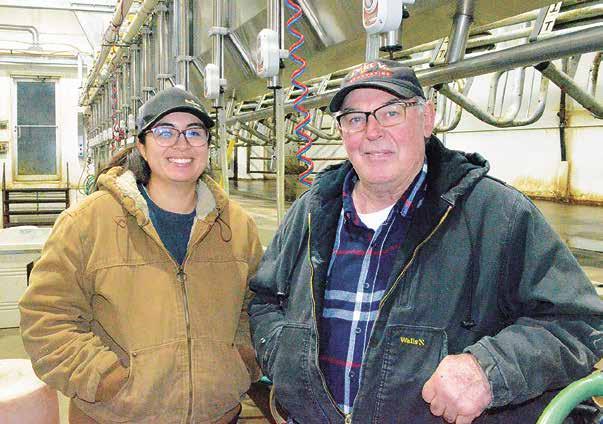
“We moved tractors, feed wagons, cows and heifers,” Lastiri said. “I put 24,000 miles on my pickup, and ever since then, it’s been parked in my garage.”
The move was prompted by Lastiri’s daughter and son-in-law, Natalia Lastiri and Jose Perez, who wanted to return to the industry and found it difcult to nd a market in Oregon.
“In Oregon, once you quit the dairy, you’re out,” Lastiri said. “There is no way to get back in. We found this dairy with
the good creamery, so we came.”
After the family sold their dairy facilities in Oregon, they retained their youngstock. Their heifers were rst housed in Nebraska and later moved to a heifer grower in Minnesota.
Today, Lastiri milks 500 cows with Natalia and Jose. Lastiri mixes feed every morning while Jose milks the hospital cows. Natalia feeds calves and helps with other projects throughout the day. There are four additional employees who help with milking and various chores.
The herd consists of Holsteins, Jerseys and crossbred cows. Lastiri does not use A.I. and rather has breeding bulls.

“This is how we did it in Oregon, and it’s working here,” Lastiri said. “We use the best bulls that money can buy.”
Cows are averaging 72 pounds of milk per day with 3.48% protein and 4.15% fat. Recently, Lastiri said 65% of the cows were conrmed pregnant at 160 days in milk.

“A lot of guys want to brag about 100 pounds of milk per cow, but this
is what we always got,” Lastiri said. “The cows are healthy.”
Lastiri grew up in Spain and came to America when he was a young man. He began herding sheep in Chino, California. After ve years, Lastiri obtained legal residency and began
milking cows at a dairy farm in Idaho. He eventually became herdsman for the farm and worked there for 18 years.
Then, Lastiri managed another dairy farm in Idaho where they milked 2,500 cows in a 80-stall rotary parlor. He worked there for
two years before buying his own farm in Oregon in 2003 at the age of 50.
“I bought an old, beatup dairy after managing two beautiful big farms,” Lastiri said. “I had a beatup feed wagon, a beat-up
old loader and 150 cows. That was my start.”
Lastiri built up his dairy farm little by little. When he sold in 2020, the farm had a new parlor, and they were milking 1,200 cows.
Lastiri still owns the 800 acres of cropland in Oregon which is rented out.
Lastiri said one of the biggest challenges to overcome in managing the Wisconsin dairy was the shift in manure management.


In Oregon, Lastiri was composting manure. The dried compost was used for bedding and spread on the elds. In Wisconsin, sawdust is used for bedding, and Lastiri has had to learn how to utilize a manure pit.

“Last year, we paid guys to haul manure, and in two short days, it was $10,000,” Lastiri said. “I said I think we need to do this ourselves.”
They purchased a manure pump, a manure truck and a tanker to pull behind a tractor. After trial and error, Natalia, Jose and Lastiri emptied the pit themselves.
“We hauled like mad,” Lastiri said. “We’re going to try to do that every year.”

The family has spent the last year making updates to the facilities. A new double-18 parallel parlor was installed to replace the existing parlor. Headlocks and waterbeds were also installed in the freestall barn.
After a year of purchasing feed, Lastiri is looking forward to growing their own crops next year. They are working on securing more land and plan to farm 570 acres.
Lastiri said he can live anywhere, but he would not have had the opportunity to build the life he has anywhere but America.
“I like cows,” Lastiri said. “It’s been a part of my life since 1980. We worked very hard, and we made it. And now, we are here.”


• Stainless steel feed box • Heavy-duty drive
• Wheels mounted directly to wheel motors

• Main drive wheels, directly under feed weight, increases stability


• Chain Choices, #55, 62, or 662 pintle, or SS T-Rod
• Honda Engine powered (6 or 9 hp)
• 33, 43, 60, 73 bushel sizes available





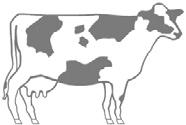






FREEPORT, Ill. – Paul Graybill grew up showing Jerseys and wanted to have his own herd. After seeing dairy setups across the country as a classier for the American Jersey Cattle Association, Graybill decided the only way to have a small dairy and remain protable was to diversify by processing their own products.
“It starts with really good milk from Jersey cows,” Graybill said.


Graybill and his parents, Doug and Kris, have been producing and selling Deerland Dairy yogurt since 2019 on their dairy farm near Freeport.
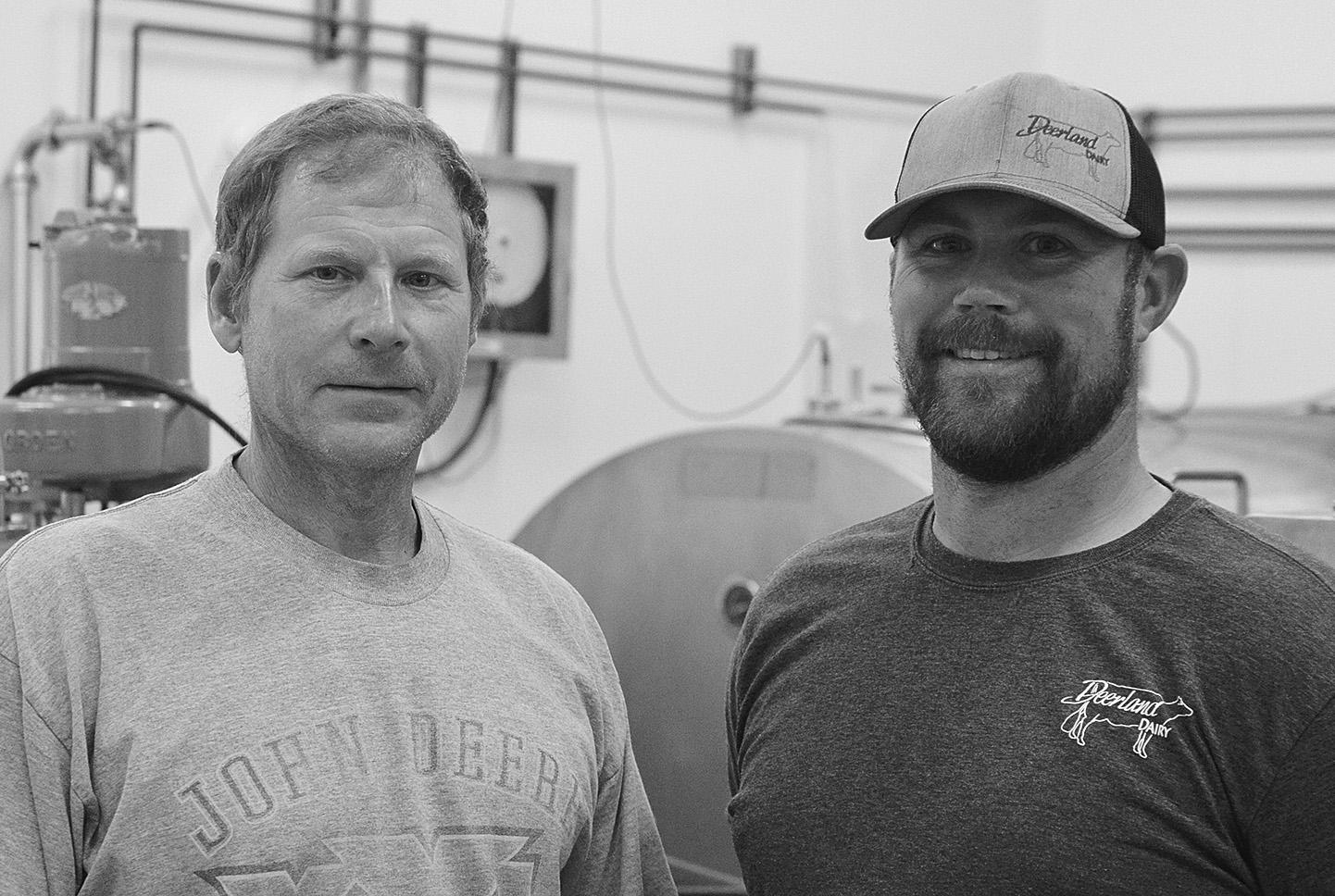
“Yogurt is one of the fastest growing products in the industry,” Graybill said. “It’s also one of the healthiest options so it’s an easy sell.”
The yogurt is made from 100% unhomogenized Jersey milk. Graybill said this adds to the avor and health benets of the product.
“The fewer processes that you run milk through the more natural it is,” he said. “Jerseys bring over 5% butterfat, and cream is all the value in yogurt. Yogurt is all about protein, and Jerseys typically run over 4% protein, so it adds to the quality.”
The process for Deerland Dairy’s yogurt begins with pasteurization. The raw milk is pasteurized and held at the pasteurization temperature for 30 minutes. It is then brought back to culture temperature. The cultures, avors and colors are added to the milk in the same vat that it is pasteurized in.
The product then runs through the pipeline to the ller machine. At this point, the product is as liquid as unprocessed milk. Cups are lled and foil tops are applied by a machine. Graybill then puts the lid on the container and sends the cup on a conveyor belt where the container is stamped with a sell-by date. It then slides down the ramp where cups are collected and put into
milk crates.
The crates of yogurt are placed in an incubating room where the product spends ve to six hours heating. The incubation process brings the pH below 4.6 and allows the product to set in the cup. After the incubation period is complete, the nished product is transferred to a cooler, where it is stored until being distributed.
Deerland Dairy products are sold in stores and restaurants throughout northern Illinois and southern Wisconsin. Kris also sells the products at a farmers market every week. Besides yogurt, the farm also produces sour cream and buttermilk. Many restaurants get their buttermilk and sour cream in 10-pound bags.
Yogurt is available in plain, strawberry, blueberry and vanilla avors. Graybill said their best-selling avor is plain, especially at the farmers market.
“People who want a high-end product like this want to add their own things to it,” Graybill said. “They like to buy plain yogurt and add berries or local honey from the market to avor it.”
Originally, the Graybills milked up to eight Jersey cows and processed all of the milk into their own products. Doug milked in the morning before going to work as a pipetter, and Graybill milked at night after working as a hoof trimmer during the day. When Doug had back surgery in 2020, however, the cows were rehomed to Kilgus Dairy in Fairbury. The Graybills now own 25 cows, all of which are housed elsewhere.
The move was bittersweet; the whole reason for making yogurt was to be able to have the cows. However, the partnership with Kilgus Dairy opened doors for the Graybill family. Because Kilgus Dairy processes all of their milk into products under their own label, they have been able to help distribute the Deerland Dairy products alongside their own.
Once a week, the Graybills deliver their products to Kilgus Dairy and bring milk back for their production. Kilgus Dairy milks all Jersey cows as well.
could work together as a family and raise kids on a farm,” Graybill said. “This is the way for small farmers.”

What counties or area do you cover? I have a lot of different counties that I have farms such as Swift, Kandiyohi, Cottonwood, Meeker and Stearns counties.





What do you enjoy about the farmers you work with? I love getting to know the farmers and how everything is going with them. Every farm is different, and it’s fun to see how different farmers do different things.
What do you like about your work for DHIA? I enjoy working around animals and people, so this job was a good t for me. I’m glad DHIA can help farmers in making their farm the best it can be. It’s a great company that’s centered on helping any farm big or small.




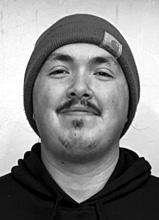







What do you do in your free time? My husband and I have four teenagers so I keep busy with their sports and events. We also live on a hobby farm with horses, goats, chickens and a big garden.





Sauk Centre, MN Buffalo, MN 763.682.1091 www.mndhia.org


MEDFORD, Wis. – For Joe and Christy Tomandl, organic dairy production is not necessarily the easiest path.


But, the path they have trodden is the right one for their family.
While holding steadfast to their beliefs, the Tomandls, of Medford, were given the 2022 Wisconsin Leopold Conservation Award Nov. 17 in Madison.
“Organic production is a tough business to be in,” Joe Tomandl said. “It can sometimes be hard to nd the value added with the increased costs of organic inputs. But if you work hard at managing those costs and maintaining your margins, the benets are worth it.”
With their three children Joe Jr., Abigail and Carlissa – the Tomandls operate Tomandl Farms.
Tomandl Farms is comprised of three organic dairies straddling the lines of
Taylor and Marathon counties.
The Tomandls milk about 500 cows between the three sites and farm 1,200 acres; 750 of those are devoted to pasture for grazing, while grass hay is raised on the remainder and harvested as baleage or haylage.
All of the corn and concentrates are purchased. The Tomandls have 12 employees who work on the three farms.
“Grazing is all I have ever really known,” Tomandl said.
Tomandl was raised on a small dairy farm that relied heavily on grazing, and in 1998, he began to forge his own career as a dairy farmer by purchasing what would become the rst of the three farms.
He set out on a path similar to that of his parents: A conventional dairy farm where the cattle are grazed.
“There was a grazing plan in place for this farm; the lanes and the fences were all there,” Tomandl said. “I understood the mod-
el, and it was a good way to get started.”
The Tomandls began grazing and milking 40 Jersey cows in a tiestall barn.
The original grazing plan was written by long-
time Marathon County conservationist Paul Daigle, who nominated the Tomandls for the Leopold Conservation Award after working with the couple throughout their career.
After nearly 20 years of operating much like an organic dairy but without the certication, the Tomandls decided to make it ofcial in 2017 and began the process of certifying their farms and their herd.
“With the dairy markets the way they were, we began looking at ways to continue to stay viable and relevant,” Tomandl said. “We looked at getting certied. It represented a fairly stable market, knowing where your price would be at for the year. The land was already basically organic. All there was to do was go through the process for the cows to become certied.”
Being willing to change, adapt and try new things to bolster their prot margins has been a hallmark of how the Tomandls choose to operate their business. For two years, they removed all grain and concentrates from the ration and procured a spot on an all-grass-based milk route. In 2020, they added grain and concentrates back into the ration.
With an eye toward improving both the environment and their farm, the Tomandls maintain their pastures by no tilling or interseeding into one-third of their existing pasture stands. They place a focus on trying new grasses, blends or improved varieties.

“We try to utilize as much grass as possible to cut back on our feed costs as much as we can,” Tomandl said. “At rst we thought it better to supplement (a total mixed ration) with managed grazing, but now we’ve moved to the philosophy that it is better to supplement managed grazing with TMR.”
The Tomandls try to appropriate up to 75% of the herd’s dry matter intake from grass for at least six to seven months of the year and an average of 55% throughout the year in order to keep feed costs in check.

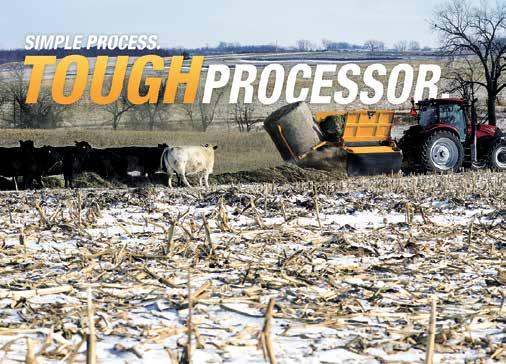


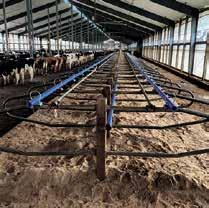

In an effort to achieve the maximum results from the pastures, Tomandl has taken part in a paddock tracking program to more efciently manage his grazing program.
“We have a sonar mounted to the front of a four-wheeler and drive that through the paddocks,” Tomandl said. “That maps the paddocks and can tell us about the tonnage that is available for grazing and helps us determine if we need to be switching more frequently or grazing a bit longer to get the best utilization of
the grass that is available to us.”
As he worked to keep his farms running efciently, Tomandl witnessed what he considered to be a void in the dairy industry, and he set about nding a way to ll it.






“It was hard to nd key people to work on the farm,” Tomandl said. “Farming is tough to learn in a classroom. That is how the Dairy Grazing Apprenticeship was created, to bring those key people into the industry through structured work training. It is geared to create that pathway into dairy farming.”
The two-year program requires a total of 4,000 hours to be invested by the apprentice, 300 in the classroom and the remaining 3,700 on the farm. Since its inception in 2010, there have been more than 60 graduates of the program.

Because he sees dairy farming as a constantly changing and evolving endeavor, being recognized with the Wisconsin Leopold Conservation Award is an experience Tomandl said is humbling.
“Just to be named a nalist was such an amazing honor, and to be recognized as the winner is something I cannot even dene,” Tomandl said. “The nalists this year were such an accomplished group. It was just a privilege to be recognized among that group.”





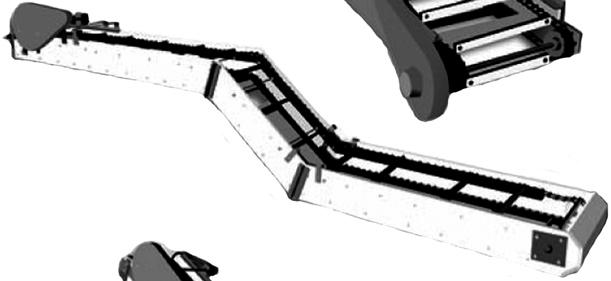





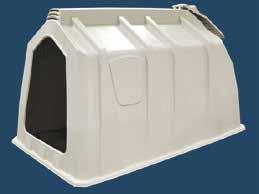
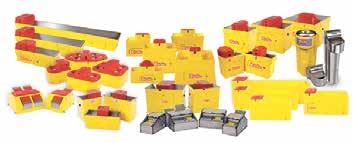









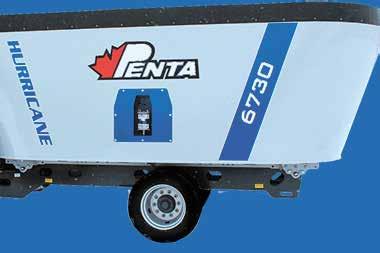




























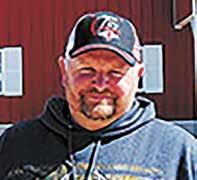
What is the size of your stalls and the depth of sand within them?
The head-tohead stalls are 48 inches wide and 14 feet long. The outside rows are 48 inches wide by 9.5 feet. Stalls are bedded with 8 inches of sand. We don’t have brisket boards.



What benets do you see from using sand bedding? We see less lameness, fewer injuries from slipping in the alleys and increased milk production.
How often do you replace sand or put sand in stalls and what is the method of adding sand? We add sand to the stalls twice a week using a skid loader and bucket.
How do you maintain and clean your stalls? Three times per day before the cows in that group get milked, we scrape out dirty or wet sand with a hand scraper.
How do you get rid of or recycle used bedding?
We have a ush ume that the sand and manure is scraped into when they clean the pens three times per day. The ume delivers that to the mechanical sand separator, which is located in a separate building. Our mechanical sand separator is a one-shot made by Daritech Inc. After 3-7 days, we move the sand with the payloader and pile it up next to the freestall barn to bed the stalls. We also have a vibrating slope screen to help clean the water to aid in sand separation.
What challenges can arise from using sand bedding? How did you solve those problems? There is a downside. Sand wears on equipment and concrete and everything. The production increase outweighs the extra expenses caused from sand. You can’t really solve those problems. Sand gets everywhere.
Tell us about your farm. The farm is owned by Eric and Chassidy Klein and Dean and Lois Klein near Lake City, Minnesota. We milk 700 cows and ship our milk to First District Association. We farm 2,000 acres. We also raise our heifer replacements and dairy crossbreds.
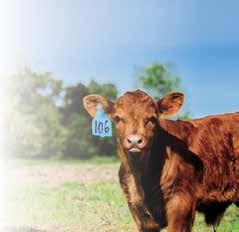
What is the size of your stalls and the depth of sand within them? The stalls are 48 inches wide and 17 feet curb to curb. Sand bedding is 8-10 inches deep.

What benets do you see from using sand bedding? Cow comfort is the main benet. We do not see any perching on the stalls. The hygiene scores are better, and we see more condence in the herd as far as mobility and traction.
How often do you replace sand or put sand in stalls and what is the method of adding sand? Stalls are raked three times a week and bedded once a week. We add sand with a sand shooter attachment on the skid loader.
How do you maintain and clean your stalls? We have a hoe that we use to scrape stalls as we collect cows at milking time. If there is any defecation or urine, we rake it out.
How do you get rid of or recycle used bedding? The sand gets scraped into the manure pit with the manure and then applied to elds when the pit is emptied.
What challenges can arise from using sand bedding? How did you solve those problems?
The manure pit needs to be managed. We bought a large enough pump and tractor to agitate everything so it could be hauled. Sometimes we use two pumps. Another challenge is that the cost of trucking has doubled in the last six months. We are looking into ways to haul our own to save on that cost. When sand is delivered on cold days, it tends to clump. We manage that by putting it in the stalls right when it is delivered.
Tell us about your farm. We are a cash crop farm and wanted to dairy. We farm 4,000 acres of corn, soybean, alfalfa and small grains. I have always been involved in the dairy because I love cows and the industry. Our milk is shipped to Foremost Farms. We have an excellent team and are excited about the future.


What is the size of your stalls and the depth of sand within them? Stalls are 4 feet wide and 9 feet long, 70 inches to the brisket curb. Sand is about 4 inches deep. We have pack mats in so we only use about half of deep bedded sand.
What benets do you see from using sand bedding? Mainly just cow comfort. We don't deal with hock or leg issues, and typically, cows stay cleaner so the somatic cell count stays lower.
How often do you replace sand or put sand in stalls and what is the method of adding sand? We typically add sand every seven or eight days. We have a sand shooter on a skid loader to put it in.
How do you maintain and clean your stalls? Two or three times a day, we go through and scrape off manure and level off any stalls that need it.
How do you get rid of or recycle used bedding? Used sand goes into the manure pit. We don't reclaim sand.
What challenges can arise from using sand bedding? How did you solve those problems? We started using it when we built a new barn in 2014. We did it strictly for cow comfort, hoping it would improve cow health and milk production. Sand wears out my blades on ally scrapers and wears holes in the manure pump over time. Those have been my most common problems. It requires more maintenance on those pieces of equipment.
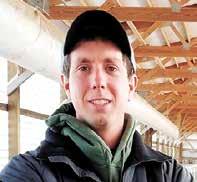
Tell us about your farm. We milk 65-70 cows with a Lely A5 robotic milking system. Our milk is sold to Chula Vista Cheese. We farm around 275 acres. It's a small family farm with just my wife and two sons and lots of tractor driving from my father.
 Eric Klein Lake City, Minnesota Wabasha County 700 cows
Eric Klein Lake City, Minnesota Wabasha County 700 cows
What is the size of your stalls and the depth of sand within them? The outside row of stalls along the curtain are 4 feet by 9 feet. The inside row toward the feed alley are 4 feet by 8 feet. We run 10 to 12 inches of sand with a clay base.
What benets do you see from using sand bedding? We started using sand two years ago. The farm was setup for it when we bought it. All of the swollen hocks and legs have gone away. I really like the sand for traction; the cows have better footing. Our somatic cell count has gone down, but we also made some other changes at the same time. It is hard to tell if it is a benet of sand or not.
How often do you replace sand or put sand in stalls and what is the method of adding sand? We rell the stalls once a week. We use the skid loader with a dirt bucket and dump over the top. Eventually, the plan is to get a sand shooter.
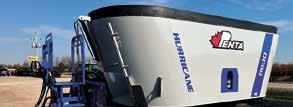

How do you maintain and clean your stalls? We maintain them by hand right now. We scrape and level them twice a day when we go to push cows into the holding area.
Hendrickson Belleville, Wisconsin Green County 110 cowsWhat is the size of your stalls and the depth of sand within them? We have three different-sized stalls in our 60-stall tiestall barn. All stalls are 76 inches long, or a little over 6 feet, and most are 56 inches wide. We have a 3-inch PVC bedding saver pipe in the back of the stalls and a 9-inch curb in the front of the stalls. Before adding sand, we ripped out the pasture mats and left the standard rubber mat beneath intact. It provides a nice, at cushion on top, and then I go as deep as I can with the sand which is about 9 inches initially and keep the stalls as full as I can. Half of our cows live in the tiestall barn and half live in our renovated freestall barn. We bed with sand in both barns.
What benets do you see from using sand bedding? The biggest benet we see is the quality of laying time. When I walk in the barn, all the cows are lying down. And if I walk through the barn, the cows won’t even get up. In the past, when I pushed in feed or cleaned up, cows would jump up left and right. We have no swollen hocks, and we went up a little in milk too. If you can improve cow comfort and efciency by putting sand in, it’s worth it. My mom was concerned about milking on sand, but she actually nds it more comfortable than the mats. I’ve had knee issues, and since putting sand in, my knees haven’t bothered me as much. We have more cushion now when stepping up and down in the stalls. Sand also saves me time as I don’t have to bed the cows every single day. I go through and rake and clean the stalls. It saves me a half hour every morning not having to shake straw. Putting sand in only takes 15 minutes.
We started using sand in our tiestall barn Oct. 28. The freestall barn has been bedded with sand since my parents bought the farm in 1991. It is benecial for these cows to be on sand. Previously, our cows were on pasture mats, and I didn’t like how hard the cows’ feet got. This made them more susceptible to getting a sore foot and didn’t allow for good foot growth. When we trimmed the cows, they hardly had any shedding or pad, just a at, hard sole wore down to nothing. Seeing the difference of cows’ feet in the free stalls versus the tie stalls and the amount of lameness
How do you get rid of or recycle used bedding? This has been the biggest problem. Sand is the best bedding until it leaves the stall. We have been slowly getting a system worked out over the last two years. The barn is scraped into a reception pit that holds about ve days. We can get about 30% of the sand settled out. Then it is pumped to the big pit, which has been the main source of our problems. We inherited a full pit of sand when we bought the place almost three years ago, so it has been a slow battle. Between what sand settles out in the reception pit, and with the boat in the big pit, we are managing it now. Currently, we are not reusing the sand. We've been told it's very hard to reclaim the ne sand that we use.
What challenges can arise from using sand bedding? How did you solve those problems? Sand is hard on everything it touches, so you need to pay attention to your manure system more. The biggest challenge is handling it once it leaves the stall. People want to sell you a hundred different things to handle it. We're still guring this out and trying to keep it as simple as possible. The more moving parts, the more headaches.
Tell us about your farm. I have been milking for ve years now. I started out by remodeling my parents’ tiestall barn and renting the land from them. My dad has helped since day No. 1 and is a huge help. Then, a farm with a freestall barn a mile down the road came up for sale three years ago, and my wife and I bought that. A year later, we moved into it and went from 50 to 80 cows. We ship our milk to Ellsworth Cooperative Creamery. Now, my wife is home full time and helping. Dad also has beef cattle, and we farm about 400 acres.
the tiestall barn cows had over the freestall cows was a big push for putting sand in.
How often do you replace sand or put sand in stalls and what is the method of adding sand? We add new sand in the tiestall barn once a week with a skid loader and sand shooter. If we didn’t switch cows in and out and have them tracking sand out every time, we could probably go every two weeks before adding new sand.
How do you maintain and clean your stalls? I have to be more aggressive initially with the trainers than I would like, but I don’t want cows making a mess under themselves. I don’t like to see manure, so I’m always cleaning under the cows. In the morning, I go through and groom the stalls with a garden rake and pull out any wet sand. I also do that at night before the cows come back in the barn.
How do you get rid of or recycle used bedding? We spread it on our elds. We’ve always had sand because of the free stalls. We spread a load every single day and have had no issues on the elds. We don’t recycle it; we use fresh sand all the time.
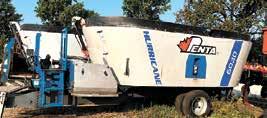




What challenges can arise from using sand bedding? How did you solve those problems? Wear and tear on the barn cleaner and putting sand on the land are challenges that can arise. We have a standard barn cleaner, and we recently put a plastic liner in the gutter so the barn cleaner chain and concrete at the oor of the gutter do not wear out as fast. Nobody wants barn cleaner troubles especially in the winter, but the barn cleaner doesn’t pay your bills. I don’t think the amount of sand we’re using will affect the land, but our agronomist will tell us next fall when he takes soil samples. The availability of sand long term is something I also wonder about.
Tell us about your farm. I farm with my parents, Jeff and Kate, and my wife, Riley. Our daughter, Adlee, is 1, and we have another child on the way. We milk between 110 and 115 registered cows at Jeffrey-Way Holsteins. We milk two groups of cows in our tiestall barn. We have 60 Excellent and 55 Very Good cows, none lower. Our average classication score is 90 points. We breed for type, production and longevity. Cows average 90 pounds of milk, 4.3% butterfat and 3.4% protein. We ship our milk to Klondike Cheese in Monroe, Wisconsin. We farm around 300 acres and make a lot of baleage which we top-dress with corn silage, haylage, high-moisture corn and protein when feeding cows. Genetics has always been the main goal for our farm, which has allowed us to milk fewer cows and have a successful operation.

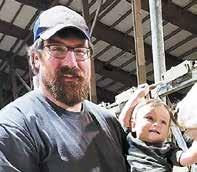








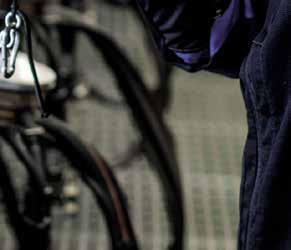







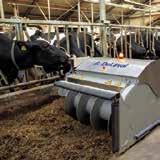
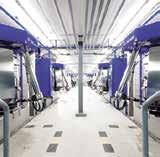


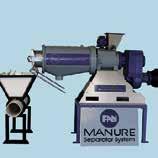



Kevin and Ben Pearson Britannia Dairy Flandreau, South Dakota Moody County 1,100 cows

Describe your facilities and list your breeding management team. One of our freestall barns is naturally ventilated while the other is tunnel ventilated. We bed our free stalls with sand. All of our employees, including our milkers and our cow pushers, are part of our breeding management
team because they help keep our somatic cell count low. We have found that cows with a high SCC have lower conception rates. Ben does all of the breeding.
What is your current pregnancy rate? Our pregnancy rate is 42%.
What is your reproduction program? We use a double ovsynch on all of our rst services. We also give the animals two shots of luteinizing hormone 24 hours apart. We use activity monitors to catch animals that didn’t settle and perform pregnancy checks every two weeks.
How do you get animals pregnant? We have recently been giving a shot of GnRH at the start of estrus. This has increased our conception rate by 5%.


Describe your breeding philosophy. Our goal is to get more than 90% of our herd pregnant after three services.
He has an app on his smartphone that he uses to access this informaon from anywhere at any
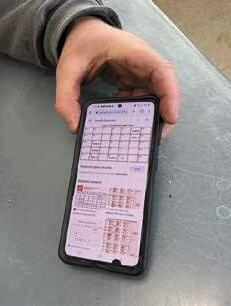


What guidelines do you follow to reach the goals for your breeding program? We aim for strict
compliance regarding the shots that we give our animals and keep up on the activity transponders. A good transition program is critical to reproductive success. We have started giving a calcium binder to our transition animals.
What are the top traits you look for in breeding your
dairy herd and how has this changed since you started farming? We look for sires with sound health traits, good udder height and width, and a positive daughter pregnancy rate. Our herd is mostly Jerseys, and we recently started crossbreeding with Holstein sires. We monitor the stature of
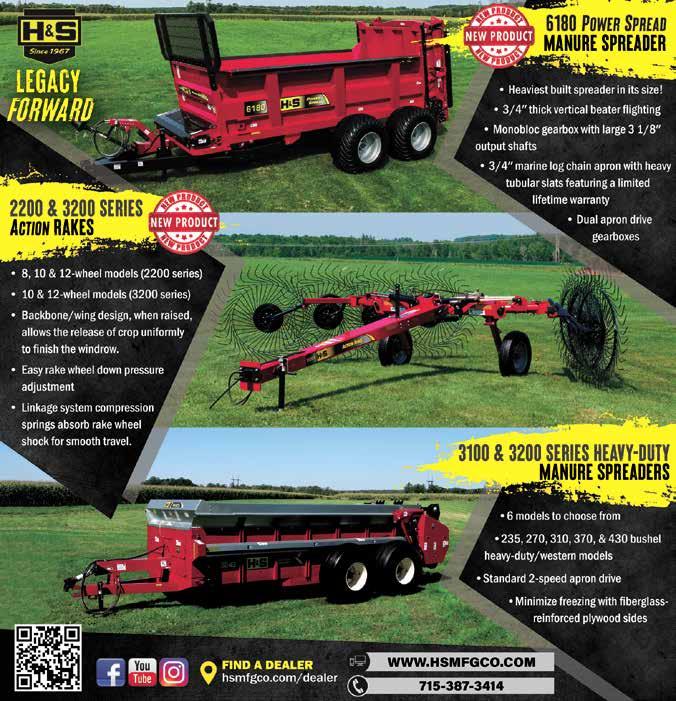
our Holstein sires and only use bulls that are easy calving.
What are certain traits you try to avoid? We avoid a large stature and a low DPR. If a rst calf heifer isn’t performing well in the milking parlor, we
“Udder Comfort™ is like ketchup. We put it on everything, and it makes everything better! We have been using this product forever, especially on fresh cows for 4 to 5 days after calving. It also softens and heals flareups fast. Other products don’t do anything. Udder Comfort brings down swelling faster, so why use anything else?” says 4th generation dairywoman Ashley Olson. She works with cows every day at Jo-Al Acres, where she and Jeff milk 50 in a crops and grazing operation near Coon Valley, Wisconsin.

















Their 14-year-old son Jed hopes to be the 5th generation in dairy. We met him checking feed and helping Jason and Leah James of Pine Valley Farm, Mineral Point get their Pine Valley Justice Carlin ready for the World Dairy Expo Milking Shorthorn show.


Leah and Ashley went to college together. They share a passion for cows and for moving dairy forward. They also share a pack at Expo and love the results they get with Udder Comfort at shows and for their respective herds at home.








won’t hesitate to ship her. Selecting sires is a balancing act.
Describe the ideal cow for your herd. She is an F1 Jersey-Holstein crossbred with high milk production, a welldeveloped udder and proper leg set.
What role does genetics have in reaching the goals of your farm? We hope that crossbreeding with Holstein sires will help us achieve our goal
of producing more energy-corrected milk. We use top sires whenever they are available.

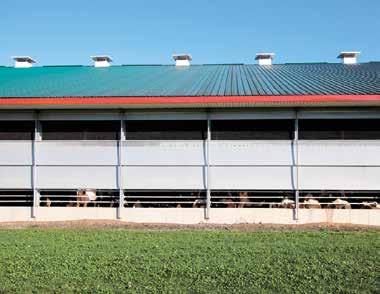
What percentage of your herd is bred to sexed, conventional and beef semen?



All of our heifers are bred the rst two services with sexed semen; after that, they are bred with beef bulls. We use sexed semen for the rst two services on the cows that we want to produce replacements. The rest of our cows are bred to Charolais sires.
What is your conception rate? The conception rate for our rst service is 50% to 60%. We have seen little difference in the conception rates between sexed, beef and conventional semen.
What is the greatest lesson you have learned through your breeding program? Get the shots into the cows at the right time, and make sure your activity transponders are working. We know how the system works and are constantly trying to improve.
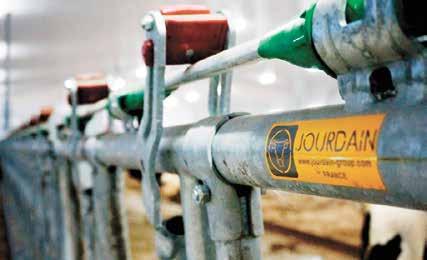
What is the age of your heifers at rst service? Our heifers receive their rst service at 12 months of age.

How does your heifer inventory affect your breeding program? We keep track of our heifer inventory and use more sexed semen if our numbers start to get low. Economics dictate that we keep our pool of heifers as small as possible. But, we also want to retain the ability to cull a rst calf heifer if she isn’t performing.
Tell us about your farm. We moved here from North Yorkshire, England, in 2007. We purchase all of our forages, and our heifers are raised by a heifer grower located in southwest Kansas. At 10 months of age, our heifers are taken to M & M Livestock at Chandler, Minnesota. Our heifers arrive back at
our
farm at three weeks prior to calving. Over the past few years, we have received


















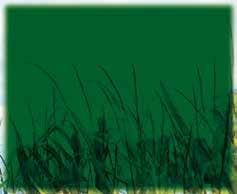


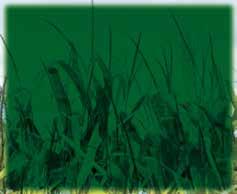





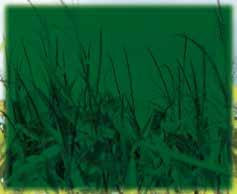


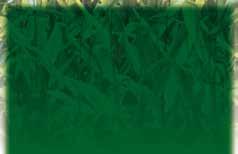


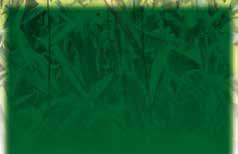








IOWA

Kramer Bros. Monticello, IA 319-465-5931
Prairie Land Ag Supply Inc. Rock Valley, IA 712-476-9290
United Dairy Systems, Inc. West Union, IA 563-422-5355
DeLaval Dairy Service Kaukauna, WI 866-335-2825
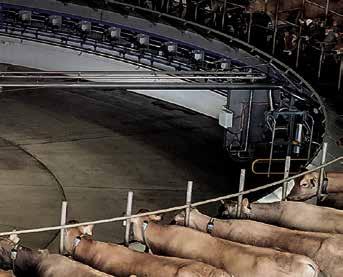
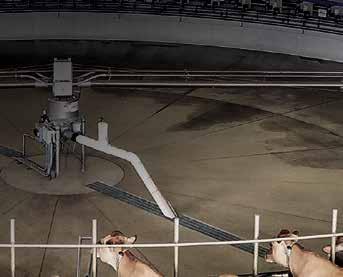
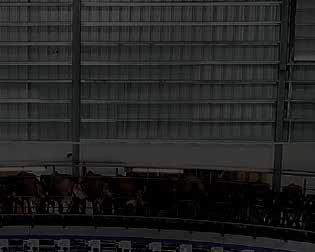

Joe’s Refrigeration Inc. Withee, WI 715-229-2321



Mlsna Dairy Supply Inc. Cashton, WI 608-654-5106
Professional Dairy Services Arlington, WI 608-635-0267


My dad was a big believer in cutting down our own Christmas tree out of our own woods. To go to the store and buy one would be a travesty in his mind.
We would bundle up, drive over to what we called the pines, which was a part of the farm that had a big stand of pine trees, and trudge through the snow (usually) to nd the best tree we could.
Dad would describe these trees we brought home each year as full of character. Most people would probably think they were a second cousin to Charlie Brown’s Christmas tree.
WISCONSIN
Advanced Dairy Spring Valley, WI 715-772-3201
Ederer Dairy Supply Plain, WI 608-546-3713
Redeker Dairy Equipment Brandon, WI 920-346-5579

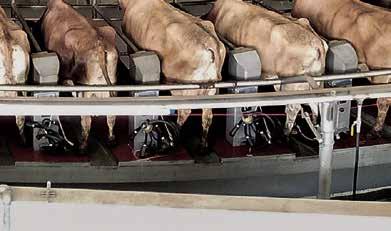
The Scharine Group Inc. Whitewater, WI 800 472-2880 Mt Horeb, WI 800-872-3470

MINNESOTA & SOUTH DAKOTA
Farm Systems Melrose, MN 320-256-3276 Brookings, SD 800-636-5581


Advanced Dairy Mora, MN 320-679-1029 Pierz, MN 320-468-2494 St. Charles, MN 507-932-4288 Wadena, MN 218-632-5416

Several times, my dad would collect extra branches, and he would use those branches to make pine bough swags that he would tie up on the posts in the barn, decorating the barn for the holiday too. We used kiln-dried shavings as bedding in the barn, so the barn always had a slightly piney smell, but the smell from those pine boughs was so much different – better and more alive.
By Danielle Nauman Staff Writer
When we would get the tree home, there would usually be some sort of engineering required to convince the tree to cooperate. Some years, the trunks were slightly crooked. Sometimes, the tree had to be tied to the curtain rod.
One year, the best we could nd had some rather large gaps. Not to be deterred, my dad drilled holes in the trunk of the tree and inserted additional branches to ll in the blank spaces.
My mom often recounts the tree Dad brought home for their rst Christmas. When it stood alongside the old brick farmhouse they lived in, the top of the tree bypassed the tops of the upstairs windows. That one required quite a bit of engineering.
We never had trouble with needles falling off our fresh-from-the-woods trees, except for in 1988, which had been an incredibly hot and dry summer. That year, needles were falling off as we drug the tree home. The vacuum cleaner got plugged up a couple of times that year.
Once the tree was up and (hopefully) secured, Mom would dig out the boxes of ornaments, all which had a story behind them.
When I was a kid, my grandma Nauman would give us ornaments every Christmas. My favorites were the ones she made when her and my mom would go to ceramics classes at a lady named Etta’s house, near Wilton, Wisconsin. I used to go along and paint small simple things myself. I always loved going to Etta’s, so those ornaments bring back many good memories. As I grew older, I started collecting cow ornaments and probably have enough of those for at least one entire tree.
As we grew, once in a while, Dad would cave and would pick up a tree from the local grocery store, but they were never quite the same as the ones that came from the pines. I am grateful that my own son was able to experience the tradition of going out into the pines with Grandpa to nd a Christmas tree.
I hate to admit that I haven’t put up a Christmas tree in several years now. Dad died the day after Christmas in 2010, and honestly, the holiday has never been the same for me. Once Austin grew older and December became a busy month with hockey and other activities, it seemed more of a chore than something delightful to do.
There have been several years, around late October, when I think this will be the year I’ll get another Christmas tree. I usually think about all the ornaments packed away in totes full of newspaper and paper towels and about going to pick out all those trees with Dad. Those memories take over and spark an interest and desire. But by the time December rolls around, any enthusiasm I may have had has usually blown out the door with the cold wind, as I have been thrust into the rigorous routine of trying to balance winter chores with work.

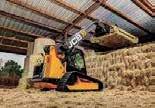 By Danielle Nauman danielle.n@dairystar.com
By Danielle Nauman danielle.n@dairystar.com









LADYSMITH, Wis. –

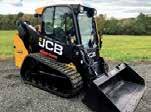



Baking soothes Janet Hetke’s soul and takes her back to a simpler time when a homemade pie could improve nearly any situation.
“I grew up making pies all my life and learned to make them at my mother’s side,” Hetke said. “A homemade pie could turn any event or gathering into a special occasion.”
As an adult, Hetke continued the traditions of her grandmother and mother and took pies to family gatherings and church socials. About ve years ago, Hetke donated a homemade pie to be sold in a silent auction fundraiser at the county fair. That pie sold for what Hetke considered to be an astounding price of $50. With that interest, Hetke began the tradition of donating pies to various fundraisers. Each donation seemed to bring a little more money, with a pie selling for $150 at the Wisconsin Ayrshire Breeders’ Association annual meeting last spring.
Hetke and her husband, Paul, milk 50 registered Ayr-


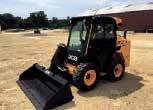
shires on their Rusk County CloverKey Farm near Ladysmith.
Through a friend, Hetke learned of legislation that had been passed for the food-based cottage industry. The 2017 Senate Bill 271, commonly known as the Wisconsin Cookie Bill, allowed for the sale of homemade low-contaminant ourbased baked goods.

“That legislation opened the door for a home bakery business,” Hetke said. “There are a lot of particulars, but it created an avenue for the sale of those items.”
The timing of that bill coincided with an ample supply of lard, which, based on what she learned from her mother and grandmother, is an ingredient Hetke considers essential to baking pies.
“My daughter and son-inlaw opened a small butcher shop, and she asked me if I would be interested in lard to render,” Hetke said. “I now have access to all the lard I could ever need and then some. “
Like adding ingredients to a mixing bowl, Hetke began putting together the pieces of her own pie-making business which
she coined CloverKey Kitchen after her family’s dairy farm.
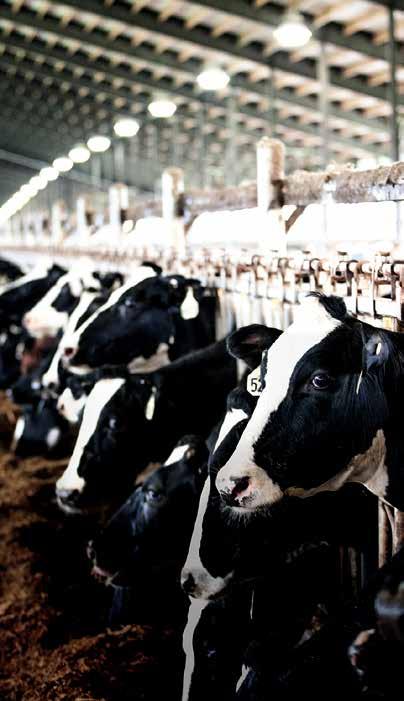
“I really agonized over pricing,” Hetke said. “Once you factor in ingredients and time, pies are not cheap to make.”
After polling friends, relatives and neighbors, Hetke set-


tled on charging $25 per pie, or a special of $45 for two pies.
Hetke began searching opportunities to sell her baked goods and was able to procure a spot at the Ladysmith Farmers Market beginning in early June.
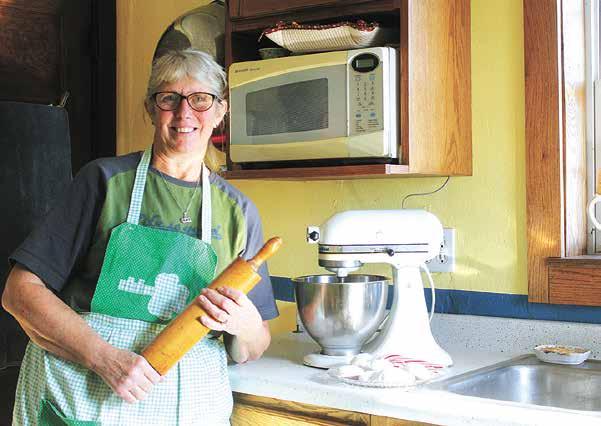
The rst week, Hetke took 10
pies to the market and sold out.
“There is something about taking a pretty pie out of the oven and admiring it,” Hetke said. “To have other people ap-



CALUMET COUNTY
• D&D Equipment
Chilton • 920-849-9304
• Stanley Schmitz Inc Appliance & Dairy Center Chilton • 920-849-4209
CHIPPEWA COUNTY
• Chippewa Farm Service, LLC Chippewa Falls • 715-382-5400
• Chippewa Valley Dairy Supply Stanley • 715-644-2350
CLARK COUNTY
• Cloverdale Equipment Curtiss • 715-223-3361
• Premier Livestock Withee • 715-229-2500
• Silver Star Metals Withee • 715-229-4879
COLUMBIA COUNTY
• Central Ag Supply Baraboo • 608-356-8384
DANE COUNTY
• Argall Dairy Systems Belleville • 608-424-6110
DODGE COUNTY
• Central Ag Supply Juneau • 920-386-2611
• Knowles Produce & Trading Co. Knowles • 920-583-3747
DUNN COUNTY
• Leedstone Menomonie • 866-467-4717
• Midwest Livestock Systems Menomonie • 715-235-5144
FOND DU LAC COUNTY
• Redeker Dairy Equipment Inc. Brandon • 920-346-5576
• Argall Dairy Systems, West Platteville • 608-348-3385
• Dickeyville Feed Dickeyville • 608-568-7982
• Fuller’s Milker Center, LLC Lancaster • 608-723-4634
• J. Gile Dairy Equipment Inc. Cuba City • 608-744-2661
• Premier Co-op Lancaster • 608-723-7023
• Scott Implement Platteville • 608-348-6565
GREEN COUNTY
• Monroe WestfaliaSurge/Koehn, Inc. Monroe • 608-325-2772
• Top Notch Feed & Supply New Glarus • 608-527-3333
IOWA COUNTY
• Farmer’s Implement Store
Mineral Point • 608-987-3331
• Premier Co-op Mineral Point • 608-987-3100
JACKSON COUNTY
• W.H. Lien, Inc. Hixton • 715-963-4211
KEWAUNEE COUNTY
• Luxemburg Motor Company Luxemburg • 920-845-2011
• Spartan Construction Luxemburg • 920-845-9892
LAFAYETTE COUNTY
• Center Hill Veterinary Clinic Darlington • 608-776-4083
MANITOWOC COUNTY
• EIS Implement
Two Rivers • 920-684-0301
MARATHON COUNTY
• Brubacker Ag Equipment, LLC Edgar • 715-613-7308
MONROE COUNTY
• Preston Dairy Equipment Sparta • 608-269-3830
PEPIN COUNTY
• Anibas Silo & Repair Arkansaw • 715-285-5317
POLK COUNTY
• Midwest Machinery Osceola • 715-220-4256
RICHLAND COUNTY
• Fuller’s Milker Center, LLC Richland Center • 608-647-4488
• Premier Co-op Richland Center • 608-647-6171
ROCK COUNTY
• Tri-County Dairy Supply Janesville • 608-757-2697
SAUK COUNTY
• Central Ag Supply Baraboo • 608-356-8384
SHEBOYGAN COUNTY
• Perfect Circle Tire Co. Waldo • 920-528-7277
VERNON COUNTY
• Koon Kreek Feeds Coon Valley • 608-452-3838
• Premier Co-op Westby • 608-634-3184
ALLAMAKEE COUNTY
• K & R Feed and Grain Dorchester • 563-568-4513
DUBUQUE COUNTY
• Brunkan Equipment Worthington • 563-855-2434
• CJ Beeps Equipment Farley • 563-744-5010
• Eastern Iowa Dairy Epworth • 563-876-3087
• Helle Farm Equipment Dyersville • 563-875-7154
• New Vienna Ag Automation New Vienna • 563-921-2896
• Roeder Implement Dubuque • 563-557-1184
• Scherrmann’s Implement Dyersville • 563-875-2426
• Skip Breitbach Feeds Balltown • 563-552-2393
• Ungs Shopping Center (IAS) Luxemburg • 563-853-2455
HOWARD COUNTY
• Farmers Win Co-op Cresco West • 563-547-3660
WINNESHIEK COUNTY
• Brynsaas Sales & Service Decorah • 563-382-4484
• Franzen Sales & Service Fort Atkinson • 563-534-2724
• Lang’s Dairy Service Decorah • 563-382-8722
• Midwest Machinery North eld • 507-645-4886
• Werner Implement Vermillion • 651-437-4435
• Caledonia Haulers Caledonia • 507-725-9000
• ESB Bank Caledonia • 507-725-3329 Eitzen • 507-495-3321 La Crescent • 507-895-2227
• Farmers Win Co-op Caledonia • 507-725-3306 Houston • 507-896-3147
• Hammell Equipment Eitzen • 507-495-3326
• Midwest Machinery Caledonia • 507-725-7000
• Ag Partners Farm Store Goodhue • 651-923-4496
• Midwest Livestock Systems, LLC Zumbrota • 507-732-4673
• Midwest Machinery Cannon Falls • 507-263-4238 Wanamingo • 507-824-2256
WABASHA
• Ag Partners Farm Store Plainview • 507-534-2531
• Beck Implement Elgin • 507-876-2122
• Leedstone Plainview • 800-548-2540
• Midwest Machinery Plainview • 507-534-3116
• Wingert Sales & Service Plainview • 507-534-2285
• Elba Co-op Creamery Elba • 507-796-6571
• Lang’s Dairy Equipment Lewiston • 507-452-5532
• Lewiston Rentals and Repairs Lewiston • 507-523-3564
• Midwest Machinery St. Charles • 507-932-4030
*Enter as often as you like. One entry per store visit, please. Winners must be 18 years or older and a Grade A or B dairy farmer for adult prize, or 17 years or younger and a son or daughter of a Grade A or B dairy farmer for heifer calf. Winners must also live in the Dairy Star circulation area to be eligible and are responsible for transport of animal.
preciate
As the summer progressed, Hetke began attending the Bruce Farmers Market on occasion as well. She enjoyed increasing success at participating in those local markets and began to branch out, adding cookies and homemade breads to the inventory she loaded up each week.
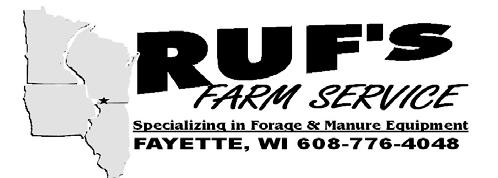
“The bread, especially, has
turned into something that has brought regular repeat customers,” Hetke said. “I have three pretty regular customers that will come out to the farm and pick up loaves of bread every week.”
Hetke developed a Facebook page to help promote her business but has found that the face-to-face contact she makes with customers at the farmers markets has been the best path-
way to growing her business.
“The farmers markets are a great way to have direct contact with the customer,” Hetke said. “That has been the best experience for me.”
CloverKey Kitchen kept Hetke busy and up to her elbows in our throughout the summer. Throughout the summer, she sold 153 pies, 86 baker’s dozens of cookies and 50 loaves of bread.
As the farmers market season wound down in late September, Hetke was left wondering how to shape her off-season marketing. She has looked into shipping her products.


“I sent some cookies to a friend who had surgery; I used an empty Pringles potato chip container for those and that worked well,” Hetke said. “A dozen cookies t the container pretty well, and the cookies made it to my friend in good shape.”
Shipping pies and breads are another story, Hetke said.
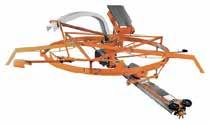

“It would be difcult to pack the pies in a fashion that they could make it through the transport in one piece,” Hetke said. “And by the time homemade bread spends a few days in the mail, you lose that freshness that makes homemade bread so good.”
Hetke has developed a pie of the month club for local customers to enjoy a variety of pies throughout the year. She also has punch cards, so a free dozen cookies or loaf of bread can be earned with the purchase of 10. With the slowing down of

the winter season, Hetke is turning her thoughts to what CloverKey Kitchen’s offerings might look like next spring.
“I am looking at starting to do some cake decorating,” Hetke said. “You can’t get a decorated graduation cake here in Ladysmith any longer, so there is maybe a need for that.”
Regardless of what direc-
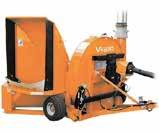


tion CloverKey Kitchen will take in the spring, Hetke revels in what she is doing.
“Baking and selling my work, this is living my dream,” Hetke said. “I love being in this kitchen. I love what I am doing. I have always encouraged my children to nd what makes them happy in life. This is what makes me happy.”





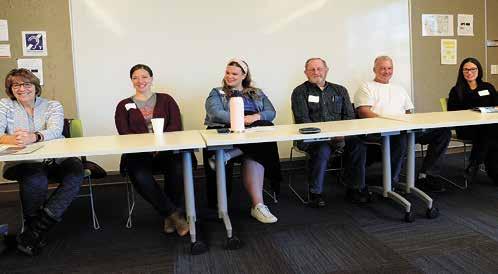 By Stacey Smart stacey.s@dairystar.com
By Stacey Smart stacey.s@dairystar.com
CEDARBURG, Wis. What does the future of Wisconsin’s small family farm look like? This was the topic of discussion as members of the community gathered at the public library in Cedarburg Dec. 3 to get a glimpse into the daily lives of ve dairy farmers.

The panel entitled “Our Dairy Farms: Present and Future” featured Peggy Schoessow of Farmdale Farm in Mequon; Shelly Grosenick of Crimson Ridge Dairy in Lebanon; Bob Roden of Roden Echo Valley in West Bend; Jeffrey Dahm of Ja-Bon Dairy Farm in Belgium; Thelma Heidel-Baker of Bossie Cow Farm in Random Lake; and Elizabeth McMullen of Organic Valley Cooperative. The moderator was Judith Friebert whose artwork of dairy farms is on display at the Cedarburg Art Museum.
Schoessow farms with her husband, Dean, and her son, Michael.
“We are probably one of only three dairy farms left in the city of Mequon,” Schoessow said. “That is hard and does have its challenges.”
Michael is the seventh generation on the farm that has been in his family since
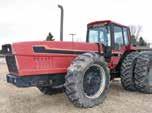



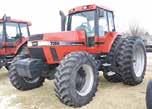
1839. The Schoessows milk 85 registered Holsteins and ship their milk to Family Dairies. Most of their milk is dedicated to uid use.
Over the years, the Schoessows have expanded and added new facilities. Cows are housed in a sand-bedded tiestall barn that was built in 1981 and added onto after Michael joined the operation. Ventilation was improved by adding multiple fans on the east side and garage doors on one side for better airow and circulation. New heifer facilities were also built with better ventilation in mind.

“My son and his wife have two little boys, and it would be nice if the eighth generation would be able to carry on our legacy in farming,” Schoessow said.



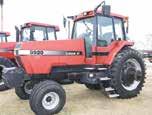

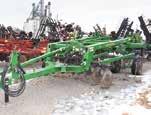
Schoessow also works off the farm, spending 40 years in corporate America. It is one of the ways she has helped her family’s small farm succeed.
“I think each and every one of us on this panel has some level of diversity,” Schoessow said. “You have to be exible and agile enough to know what’s going to work for you and your family.”
Heidel-Baker agreed.


“Think about what you’re good at and focus on that,” she said.
Three of the ve panelists have diversied into providing other avenues of income on their farm. In addition, McMullen said some Organic Valley farms diversify by offering an Airbnb rental.


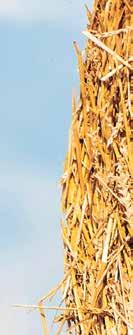








At Bossie Cow Farm, Heidel-Baker and her husband, Ricky, milk 65 cows. She is the third generation on the dairy that her grandpa purchased in the 1950s. An entomologist by training, HeidelBaker came back to the farm in 2015.
Her parents were conventional farmers, but in the last 30 years, they switched to a grazing operation. The 80-acre farm has been all pasture since 2000 and certied organic since 2003. The Bakers practice adaptive managed grazing and move cows several times a day to provide new feed. Their animals are 100% grassfed.
“Our pastures are planted to a very specic, diverse mix of grasses,” HeidelBaker said. “We also feed our cows freechoice mineral. In the winter, we feed hay, and we also do a lot of baleage. We’re really self-sustaining.”
The Bakers, who ship their milk to Organic Valley, milked once a day for a period of time to give themselves a break but went back to milking twice a day this year when the farm became fully seasonal.
“Shipping to Organic Valley allows us to get a premium price for our milk,” Heidel-Baker said. “Because we’re grassfed, we push for quality of milk versus quantity.”
McMullen, who has worked in public relations at Organic Valley for four years, said the co-op has nearly 1,800 patron farms across the U.S. Making a future for the small family farm is its mission.
“Organic Valley was founded in the 1980s to save the small family farm,” McMullen said. “That’s why we’re here, and I will continue to ght for the small family farm.”
Heidel-Baker has an off-farm job, and to further support the farm when a milk check is not coming in, she direct markets grassfed beef as well as eggs. She also helped start local farmers markets to create communities that support
the direct market food business and local farms.
“Diversity is key to our farm not growing but still being successful,” Heidel-Baker said. “We are a grazing farm – that’s our primary feed source. It’s a different model and one we found works really well for us as a small farm.”
Grosenick and her husband, Jim, are the fourth generation on their farm where they milk 200 cows. The Grosenicks ship their milk to Dairy Farmers of America where most of it stays in the uid market.
“I have two degrees from (the University of Wisconsin)-Madison and was planning to do big things with international business and ended up going back home and marrying the boy next door,” Grosenick said. “We have three children, and they are probably the reason we’re still farming and milking cows.”
Grosenicks’ cows are housed in a sand-bedded freestall barn. The family grows most of its feed and purchases the remaining. Included in their total mixed ration is grocery store refusal, such as breads, fruits and vegetables.
“We’ve tried some really creative ways to stretch our budget and keep things out of landlls,” Grosenick said.


After falling ill from an autoimmune disease, Grosenick began experimenting with healthier food options that gave way to a value-added on-farm business – Crimson Kitchen and Gardens.
Grosenick makes jams, jellies, salsa and pickles as well as raw milk soap and lotion to sell at farmers markets. She also sells produce from her half-acre garden. Last year, Grosenick partnered with a local hemp grower to make raw milk CBD soap and raw milk CBD lotion.
Roden started milking 24 cows on a 40-acre farm in 1981. He gradually grew over the years and purchased his current operation in 1995 where he farms with his wife, Cindy, and their son, Rick. The
Rodens milk 850 cows and ship their milk to DFA. In March, they began milking in a new 40-stall rotary parlor. The Rodens were planning for the future when they built the facility which has capacity to milk up to 1,600 cows three times a day.

“This is the direction my son and I wanted to go,” Roden said. “We have some robotics in there and are hoping to develop more with the possibility of needing one less person for milking in the future.”

The facility includes a viewing room, which has been benecial for Roden’s daughter, Jacki, who branched off nine years ago with Roden Barnyard Adventures – an opportunity for the public to experience the farm through camps, tours and birthday parties. Jacki has also started offering sleigh rides in the winter.
Roden said that in 1978, 300 dairy permits were issued in Ozaukee County, but today, there are about 28 farms; however, cow numbers have not changed.
“I believe there are places for all sizes of dairy farms, but it’s sad to say I think the trend is toward larger farms,” Roden said. “I call myself a medium-size farm. I have 17 grandchildren and one on the way, and I’m hoping to continue this in the future.”
Dahm milks 50 cows in a 74-stall tiestall barn and ships his milk to Cedar Valley where it is made into mozzarella and provolone.
“We used to milk 120 cows, but as my kids grew up and went away, we downsized,” Dahm said. “My son, Lucas, is still on the farm and helps out, but possibly in two to four years, I might not milk cows anymore because I’m getting wore out.”
Dahm said land rent in his area can go for $200 per acre.
“As a small farmer, I can’t afford that,” he said. “We’re close to the lake,
and yields are not as good typically. During a recent wet year, I had 50 acres I couldn’t get anything off of, but I still had to pay the rent. So, for the last ve years, I’ve been buying about half of my feed.”
Dahm feeds a TMR, and in the summer, his cows have access to four pastures they can roam at will. Two years ago, he began keeping cows outside year-round – a decision that reaped positive results for this small family farm. Dahm beds the concrete with straw on the east side of the barn, creating a big manure pack that he continues adding to.
“The cows live outside, and their legs are healthier than ever, and udder health is unbelievable,” Dahm said. “I haven’t dry treated for three years, and I’ve only treated one cow for mastitis in three years. I don’t have to feed or bed in the barn, and the cows stay nice and clean.”
The long-term viability of the small family farm came into question during the panel discussion.
“I don’t want to be critical of any size farm, but I believe it’s tough to make a living today on a smaller farm,” Roden said. “But I might be wrong. A lot of my growth is driven by indebtedness. A smaller farm that’s debt free is going to last a long time.”
Grosenick has no desire to grow larger.
“Our farm would hold 350 cows, but I personally do not want to see any more cows on our farm,” she said. “I’m having way more fun expanding my product line versus our herd.”
Each farmer on the panel has different goals but is motivated to make it in today’s dairy industry. They are innovating to not only survive but to also ourish. The hope is to build a sustainable business they can pass on to future generations.
With low equipment, operational and maintenance costs, Air King industrial air cleaners are an economical way to improve your overall air quality.


Air King industrial air cleaners are a valuable tool for capturing most airborne nuisance particulate. Our self-contained filtration units continuously pull contaminated air through multiple stages of highly efficient micro-glass filters. The filtered air is then re-circulated back into the working environment without the need for duct work. This results in a cleaner, healthier atmosphere for employees, while saving you money by keeping heated or air-conditioned air inside your facility.

Caring for a vital resource: Farmers’ hands
By Karen Johnson
A farmer’s hands are his or her lifeline. Every aspect of the day revolves around the ability to utilize their hands to get the job done. However, winter can be particularly hard on hands. Often farmers experience extremely dry, cracked and sometime painful hands during winter. The main cause is due to the lack of moisture. Cold air has a much lower moisture holding capacity than warmer air. Indoor heating systems dry out the inside air even further creating an environment that is difcult to keep skin healthy. Another factor to keep in mind is that during winter it is highly encouraged to increase hand washing due to the presence of seasonal respiratory illnesses.
The top layer of the skin, the epidermis, is the main protective barrier and where dry skin develops. When the epidermis dries out, the skin will not shed as rapidly as it normally does. This causes a buildup of thickened skin. Increased time in the cold, dry wind makes this situation worse. In addition, developing dry skin becomes more common as we age.Moreover, people who experience dry skin in previous winters are more likely to have it happen again.
– Start using moisturizers before you know that your dry skin typically starts. Moisturizing creams work well for mild dryness. Consider oils or ointment for moderate to severe dryness.
– Wear high quality, warm gloves to protect your hands when outside in the cold.
– If you don’t already have gloves as part of your milking procedures, wear gloves while milking to prevent excessive teat dip contact with hands.
– Establish an extra step in your hand washing routine. Use mild soap with warm water. Then, pat your hands dry and apply moisturizer. Moisturizing your hands several times a day combats skin dryness more effectively than one daily application.
– The best time to moisturize is immediately after a shower or right before bedtime.
– Contact a medical professional if your symptoms are more severe.



As farmers, we know equipment breakdowns happen even at freezing temperatures. In these situations, you can do one of two things. One being to determine a different way to complete the necessary tasks without the broken piece of equipment until it warms up enough to x it. This is not likely on most Minnesota and Wisconsin dairy farms as each piece of equipment is required in the daily operation of the farm. The other option is to x the broken equipment in the safest way possible. Move equipment inside if you can, wear the necessary layers of clothing and gloves to stay
warm and know the signs of frostbite. Frostbite is the extended exposure to extreme cold that leads to damage to the skin and underlying tissue. Pay special attention to your hands and feet, as they are the rst to show signs of frostbite. First signs include cold skin with a prickling feeling followed by numbness and inamed or discolored skin.
Having dried, cracked and painful hands during chores is not a desired way to work through winter on the farm. Take the necessary steps now to protect your hands before the winter damage becomes extreme.
Dana Adams, adam1744@umn.edu 320-204-2968
Joe Armstrong armst225@umn.edu 612.624.3610

Luciano Caixeta lcaixeta@umn.edu 612-625-3130
Gerard Cramer gcramer@umn.edu 612-625-8184
Marcia Endres miendres@umn.edu 612-624-5391
Joleen Hadrich jhadrich@umn.edu 612-626-5620
Les Hansen hanse009@umn.edu 612-624-2277


Brad Heins hein0106@umn.edu 320-589-1711
Nathan Hulinsky huli0013@umn.edu 320-203-6104
Kevin Janni kjanni@umn.edu 612-625-3108
Karen Johnson ande9495@umn.edu 320-484-4334
Emily Krekelberg krek0033@umn.edu 507-280-2863
Claire LaCanne lacanne@umn.edu 507-332-6109
Brenda Miller nels4220@umn.edu 320-732-4435


Erin Royster royster@umn.edu
Isaac Salfer ijsalfer@umn.edu 320-296-1357
www.extension.umn.edu/dairy WHICH BARN IS BEST FOR YOUR HERD? Birds just love this barn. The webs in these trusses are easy nest areas for birds. They also restrict air flow which leads to poor ventilation and moisture buildup in the building.
Jim Salfer salfe001@umn.edu 320-203-6093
Mike Schutz mschutz@umn.edu 612-624-1205
Emma Severns sever575@umn.edu 507-934-7828
The arched rafters create a more open barn allowing better ventilation. Also since there are no open webs in the trusses, there are no places for birds to nest. Starwood Rafters Uses Pole Sheds • Free Stalls Riding Arenas Pavilion Shelters Machinery Storage


• Spans up to 72 ft. • Up to 12’ spacing depending on the load you desire • Bird nesting control • Better ventilation & visability • No feed alley post obstruction • Additional ceiling height Starwood Rafters Lam-Ply Truss ANOTHER QUALITY PRODUCT FROM STARWOOD RAFTERS

Robotic Milking and Understanding the Complete Robot Barn Experienced experts discuss barn design, cost, labor, ops changes, plus more! FEBRUARY 28, 2023 Dubuque, IA REGISTER ONLINE Visit Fiveg.com for more information & to reserve your seat Your Dairy Engineers 522 Sinclair Lewis Ave. • Sauk Centre, MN 56378 (320) 352-6303 • Fax: (320) 352-5647 Don’t ddle around with your advertising dollars!
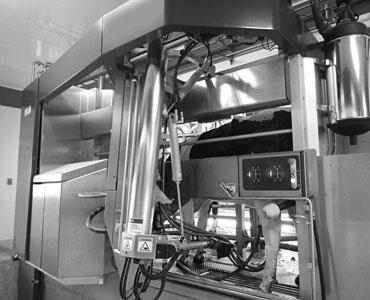

The end of the year is a good time to reect on what went well over the past year and to plan for a successful future. Building a successful farm business does not happen by accident. Business planning can be daunting and is not something that comes naturally to many people. To sustain a successful business, the owners and managers need to provide leadership and the vision to take a business into the future. It is less daunting if proven business planning principles are followed.
Figure 1 shows a process that can help a business plan their future. Here is an explanation of the steps:


– Who are we? It is important to understand that people are the key to any business’s success. Owners or potential owners should evaluate their personal and business core values. Values represent the business’s highest priorities and passions. Small business owners bring deeply held values and beliefs to the organization. This creates the farm and family culture and identity. Values should help identify the business’s highest priorities and passions that lead to the goals for the future. A farm that has a business goal of minimizing hired labor will likely make different decisions than a farm that has a goal of milking many cows on multiple sites.
– Where are we now? A SWOT analysis is a strategic planning technique that can identify a farm’s

Figure 1

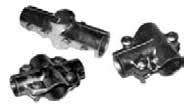


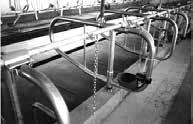

strengths, weaknesses, opportunities and threats. It can provide insights, such as where the farm should focus its energy and resources. Strengths and weaknesses refer to internal factors, and opportunities and threats are external factors. Farms should focus on maximizing their strengths. What are the strengths and skills of the owners and managers? Are they good at managing people or is cow management more of a strength? Can the weaknesses be turned into strengths through training or hiring someone to complement the owner’s weaknesses? Can your farm business capitalize on the external opportunities that are identied? Do you have the interest and resources to seriously consider any of these opportunities? Are the external threats identied likely to become real issues? Can the risk be lessened or eliminated?

– Where do we go from here? Who are the future leaders and managers of the business? Are there family members interested in joining the business? What interests and skills do they contribute to the farm? What additional education, training and experiences
will they need to be successful? If you do not or may not have family successors, what is your succession plan? Do you have an employee or employees who have the passion and skills to become partners? If so, what would be the timeline for such a transition? How will you determine that he, she or they have the passion and the skills to succeed as your partner?
Do owners or managers have skills to start another business to complement the farm? This could be a related business such as custom chopping or manure pumping. Alternatively, the business could be something unrelated such as an on-farm repair business.

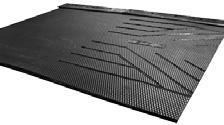
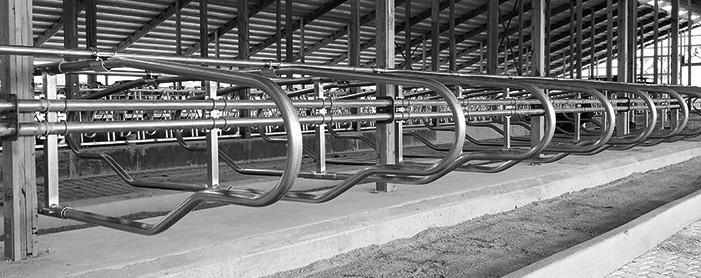

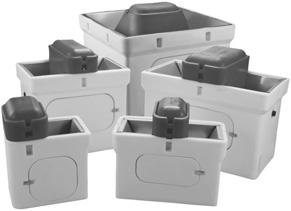
– How do we get there? The last step is to create a roadmap to achieve goals. Working with trusted advisors and others can help develop, plan and keep you on task. They can also help identify and overcome roadblocks.
All these steps are important to increase the chances of success. Trying to shortcut the process could result in a business where owners and managers are not congruent in their vision of the business. This can divide re-

sources and can create confusion between owners and managers resulting in disagreement on the direction of the farm. Taking the time for all owners and future owners to deliberately plan for the future of the business will pay dividends because everyone will be working toward a shared common goal.



University of Minnesota Extension and Minnesota Dairy Initiatives have partnered to secure a U.S. Department of Agriculture risk management grant for workshops to help dairy producers work through these steps and begin planning for the future. The workshop involves worksheets and discussion between participants. The discussion, worksheets and case studies are designed to assist owners, potential successors and other key managers develop a potential path for the farm to thrive in the future. These workshops will be held at various locations throughout the state.
Contact me at salfe001@umn.edu or 612-360-4506, your local extension educator or an MDI coordinator for more details.


Cuba City, Wisconsin
Grant County

56 cows

Family: My sister, Jennifer, is a chef at a local supper club. Her favorite dairy breed is Brown Swiss. My brother, Joseph, got married in September to Heather. Their two daughters, Allie and Audrina, love coming to the farm and working with the calves. Joseph was in the Navy and now works at a local cheese plant with Heather. Joseph’s favorite breed is Jersey, but Holsteins come in a close second. I work at Andersen Window and Door, and my two favorite breeds are Guernsey and Milking Shorthorn. My dad, Douglas, loves working on older tractors. He collects them and uses them to do eldwork. He is restoring a John Deere Model A. My mother, Teresa, loves to quilt and bake. She also loves playing with the baby calves. Her career is custom quilting.
Tell us about your farm. My parents have owned this farm since they were married in 1990. They had 32 cows in a stall barn, a German shepherd named Chester and a dream to have a family dairy farm. Now, we have a barn full of almost every dairy breed and are working on our purebred pedigrees.
What is a typical day like for you on the dairy? A typical day starts at 5:30 a.m. with morning milking, which takes about an hour and a half. Then, we feed the outside calves. Our outside calves include weanlings up to bred yearlings. Before our calves are weaned off, they live inside our stall barn and get fed milk from the tank three times a day. We milk again at 5 p.m. My siblings and I take turns milking at night, and Dad milks in the mornings.
What decision have you made in the last year that has beneted your farm? Putting cameras in our barn








and calving pens. This makes it much more manageable to check on calving cows and to make sure everyone is safe in the barn. Our cows stay inside at night in the winter. Our freestall barn is for the dry cows and the heifers.

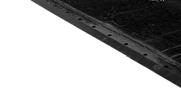
Tell us about your most memorable experience working on the farm. There’s almost too many to choose from. But my favorite had to be when we had our rst Milking Shorthorn calf born. Her name is Jelly, and she was my favorite show calf for years. I even won grand and supreme champion with her in 2014 at the county fair. Jelly will be 10 next year.

What have you enjoyed most about dairy farming or your tie to the dairy industry? My favorite tie to the dairy industry is that with a family farm I can still work a town job and work on my family’s farm.

What is your biggest accomplishment in your dairy career? My biggest accomplishment would have to be showing my cattle at multiple dairy shows across the state, putting our farm name out there and being able to teach people about the dairy industry.
What are things you do to promote your farm or the dairy industry? I promote my family’s farm by posting about my cows on social media. I love showing off my cows, funny pictures and all.
What advice would you give another woman in the dairy industry? My advice to other women would be to keep living the dream. The dairy industry is constantly expanding. There is something in it for everyone.
When you get a spare moment, what do you do? In my spare time, I enjoy working with my show cows, reading and baking.

Mayville, Wisconsin Dodge County 115 cows
How did you get into farming? I was born into it. I am the third generation on this farm. I farm with my mom and dad, and my wife and sister both work part time on the farm as well.
What are your thoughts and concerns about the dairy industry for the next year? The supply chain is really messed up right now, and I’m having a hard time nding some basic things to run a dairy. We used to buy things as we needed them. Now, it seems like if you nd it, you buy a few months’ or a year’s supply and stock it yourself just to have it. Hopefully that part of it doesn’t get worse. You don’t realize all the things you need to run a dairy farm until you can’t nd it or it’s on backorder and you have to look for an alternative product. Our industry is better off with a variety of farm sizes, but it seems like the smaller family farms are getting driven out by the bigger farms. With less people and less families in dairying, it has put a damper on the local economy, and once thriving small towns with small ag-related businesses seem to be becoming a thing of the past.

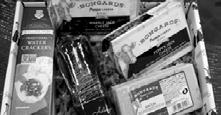

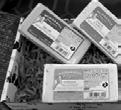

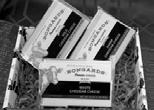

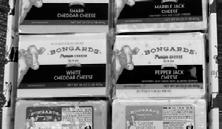




What is a recent change you made on your farm and the reason for it?





















A few years back, we built a tower silo for more feed storage. When we chop forage, many times it’s just Dad and I, and the silo makes it easier to put up good quality feed with less labor. Dad can park in one place and unload the wagon while I ll one out in the eld, and the silo holds all of our rst crop haylage. It replaces about three bags per year, and it’s nice that the feed is more centrally located to ll the mixer. There’s also no mud or plastic to deal with, keeping the yard tidier.
Tell us about a skill you possess that makes dairy farming easier for you. For the last eight years, I’ve been breeding all the cows instead of getting a technician. It’s nice to be able to breed when the cow is in the barn instead of rounding them up later and waiting for a technician. Doing it myself also saves money.

What is the best decision you have made on your farm? Building the heated shop. Equipment used to get xed in the shed or outside in the cold. Having a warm, bright shop with LED lighting allows me to do a much better job with equipment maintenance at any time of the year, and it’s also nice to keep the tools organized in one place. Also, if something freezes up, like the manure spreader, I can back it in and leave it to thaw if I have to.
What are three things on the farm that you cannot live without? The skid loader because I do everything with it. Whether it’s feeding, cleaning pens or just moving things around, it’s
one of those pieces of equipment that you need every day. Also, the fourwheeler. It’s handy to have to scout

All of us farmers seem to have a reluctance to go to the doctor. As a group, farmers put in long hours and often put our own health last on the list of appointments. We can meet with our own nutritionist, veterinarians, agronomists, bankers and farm service agents to make sure we take care of our cows and farm. But when it comes to taking care of ourselves, we often push back on making an appointment.
When my kids were young, they went to the doctor for their required checkups for vaccinations and physicals to participate in sports, but we were condent that the runny noses and coughs would clear up as their antibodies would kick in and ght the cold or infection. We did make appointments for ear aches or the occasional accident that needed to be stitched up. If it was an emergency, we went for care.
By Tina Hinchley Farmer & Columnist
In the past, we didn’t have health insurance. Now, we have coverage. I am getting text messages and emails daily to remind us to review our plan and re-enroll or the plan will roll over automatically. Looking through what is available in the plans, I also noticed the providers in our area are limited. I value the time it takes to evaluate and check that we are getting the most for our dollars.
I am a breast cancer and brain tumor survivor. I struggled many years with a brain tumor without being diagnosed. I had symptoms of severe headaches, ears ringing and eventually black spots oating in my vision. I felt depressed and had bouts with anger that were thrown at my family. I knew something was wrong and getting worse. After seeking help from a local doctor, and then not being satised with the care I received, I got a second opinion from another physician. It was in her care that I was sent for an MRI and nally diagnosed with a brain tumor. Getting a second opinion saved my life. That was 16 years ago.
Annually, I have appointments to have an MRI. Nine years ago, the brain tumor returned. Shortly after I began treatments for the brain tumor, I noticed a lump in my breast. After the exam and biopsy, it was diagnosed as a cancerous tumor. I have been cancer free for nine years.
The mammogram and MRI scans are now only once a year. The appointments are always in December. The anxiety and tension that begins to surface after Thanksgiving has a lot to do with these appointments. But, I am exhausted with the emotions that come with the holiday. It has become more stressful on many people who have been struggling nancially and emotionally with the holiday that seems to focus on spending.
I have less enthusiasm for the Christmas holiday each year. I don’t look forward to decorating and putting up a tree. I have reserved feelings about purchasing gifts that are not meaningful. The commercialization of the holiday is to blame, but I have never had to control a feeling of needing to spend money on useless items. It is a struggle to gure out why I have problems feeling sad.
After my appointments in the middle of December, I do feel a relief. Somehow, I carry a worry that I don’t recognize until the scans are read to me. It seems that my inner self is able to breathe easier,

and I have a brighter outlook for the day. I must be darkened with depression and am able to pull myself free just with the hearing that I remain cancer free.




By recognizing the feelings of darkness within myself, I am able to feel the need to reach out to others in need in our own communities. Mental health is a crisis in our rural communities. Knowing the need to reach out to others to see how they are doing can save a life. Just be a listener. Have contact with someone with a text message or phone call. Ask how their day is going and if there is anything you can help with. Often a hug goes a long way to
show you care. If you are unable to help or provide what is needed, reach out to the national hotline.
Since the pandemic, many people have reached out for help for themselves or others. Help is available by calling 988 or visiting https://988lifeline. org. The lifeline provides 24/7, free and condential support for people in distress and prevention and crisis resources for you or your loved ones.

Tina Hinchley, her husband Duane and daughter Anna milk 240 registered Holsteins with robots. They also farm 2,300 acres of crops near Cambridge, Wisconsin. The Hinchleys have been hosting farm tours for over 25 years.
and continues today.
The HiFlo Evolution pulsator embodies the efficient simplicity and rugged reliability that Lawrence Bouma engineered into his first BouMatic pulsator in 1939.

The HiFlo Evolution will become the heartbeat of your dairy as it has become the heartbeat of BouMatic.
Request more information at BouMatic.com/HiFlo. It is in the best interest for the life of your dairy. For the life of






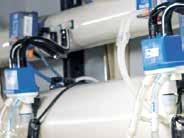
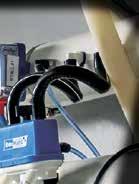
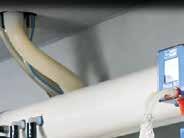
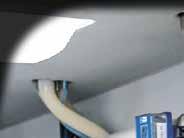







As Da Yoopers belch along in their classic deer hunting song, “The second week of deer camp is my favorite time of year.”
I remember memorizing the words of this song in junior high, because I wanted to impress all the guys who knew it. Now, I impress, or embarrass, my children with my sing-a-long skills. Either way, it amuses me.

The second week of the Wisconsin gun deer season is my favorite time of year. It has Thanksgiving, which is less stressful than Christmas, and the much-anticipated family time at deer camp.
When Grandpa Ike and the uncles, my dad included, decided to build a hunting cabin on our land in 1998, it was done so with the hopes of continuing the tradition of deer hunting as a family for years to come and having a place where all could drink, play cards and shoot the bull.
Twenty-four years later, we are as strong in numbers and enthusiasm as we were during the rst years when my cousins lled the 15 bunk beds. Back then, alongside snoring uncles and Grandpa Ike, they attempted to sleep
in a cabin that doubled as a sauna after Grandpa “Woody” stoked the re a bit too much.
Years ago, the uncles would pull in with their trucks lled with cousins, pulling trailers with four-wheelers on them. They would unload tubs of blaze orange gear, the appropriate weapons, and enough food and beverages to feed an army for the weekend.
Now, it’s the cousins, all of us parents now ourselves, arriving in trucks packed with giddy children, pulling trailers strapped down with four-wheelers behind. Everyone rolled into camp by midday on Black Friday. My children were bouncing off the walls with excitement at having quality cousin time. The boys took to the cabin or the woods that afternoon, and seven of us girls got to work on making lasagna and bars for our Saturday lunch and boiling and ricing potatoes for lefse.
Then, it was off to the barn for nightly chores with my troop of eager learners and helpers.
Thank goodness I had Gardenia in my hospital pen. She stood so calmly that everyone from age 5 to 15 could
take a squirt out of her and proudly claim to have milked a cow.
Pens needed cleaning; calves needed feeding. Many hands make light work. Many mouths make lots of squealing and a fair amount of organized chaos. The boys arrived just in time to pitch in with feeding the overowing pen of bull calves.
When I made it to the barn Saturday morning, Clarice had been in the pen for four hours with no action. Last year, Jadyn had the privilege of reaching in a cow to feel a calf. This year, Kendall decided she was ready for the challenge.
Ramblings from the RidgeTUB Free-choice supplement to enhance high-forage diets & support development of replacement heifers. STRESS TUB
Free-choice supplement with 14 essential minerals plus vitamins for young cattle prior to, or after, stress & breeding. Also used in pre-weaning.

RANGELAND 30-13 TUB




Free-choice protein supplement (30% protein) to help regulate intake on forage diets with low protein.

Free-choice blend of 14 essential macro & micro minerals plus vitamins to correct & provide consistent consumption.
digestion & optimal calf growth.
With an audience, Kendall and I investigated why Clarice wasn’t progressing. Priceless facial expressions, a few “Ewws,” a giggle or two, and we had it. Three legs and one head. One calf was coming forward out between her twin’s back legs. The entire time I was working on delivering the calves I was praying they would be alive after all this time.
By Jacqui Davison Columnist


I breathed the biggest sigh of relief. The kids were all excited to watch the entrance of Peanut and Butter into the world. No doubt that tale is one that has already been repeated countless times to their classmates at school.
Chores were done. We started on our lefse making for the day. Jadyn, Kendall and I worked on remembering our rhythm and teaching our newest recruits – Jessa, Whitlynn, Shaelynn, and Cole – how to roll thin, carry carefully and ip gently. Perhaps our most important teaching was how to eat it the proper Mlsna way: a bit of butter smothered in homemade jam rolled up tight. The lesson in smothering in jam was well executed. I am down four big jars of jam after eating all the lefse made last week.
As we worked, Shaelynn asked me, “Why do we make this?” Jadyn and Kendall answered in unison, “Tradition.”
We do this because making this food brings a bit of Grandpa and Grandma Ike back to us during the holidays, and everyone loves fresh lefse. I explained the Norwegian connection to the girls, and we shared memories of making lefse with Grandpa and Grandma with those who aren’t as lucky as we are to have those mental pictures to cling to. Aunt Sherry and Uncle Steve couldn’t make it down this year, and I became aware of being the bridge between the generations.
After a busy morning of calf pulling, lefse making and lasagna eating, we set up for our annual candy house building. I started this tradition when the oldest of this generation of cousins was 6 or so. He is now 20. It was something for the kids to look forward to doing while the men were in the woods searching for the elusive 30-point buck. Creativity runs high as kids recreate edible versions of our hunting cabin, a snow-covered roof or a deer stand.
Saturday night in deer camp equals shaking dice. We crowd around the table and put our $3 down. The volume gets louder as the money pile in the center gets higher. After two rounds, it was decided every kid under the age of 18 would split the pot. There were 11 winners grinning from ear to ear. We tacked a dollar to the wall declaring the winners of the game and denoting the year; a new tradition was born in doing so.
In the end, though, we are all the winners of the week. The treasures of the memories and laughter we shared together makes us all rich. As the clouds of dust lled the farmyard on Sunday afternoon, everyone left with full bellies, minds swimming with stories and happy, thankful hearts.
Jacqui and her family milk 800 cows and farm 1,200 acres of crops in the northeastern corner of Vernon County, Wisconsin. Her children, Ira, Dane, Henry and Cora, help her on the farm while her husband, Keith, works on a grain farm. If she’s not in the barn, she’s probably in the kitchen, trailing after little ones or sharing her passion of reading with someone. Her life is best described as organized chaos, and if it wasn’t, she’d be bored.

Any work protocol is just how we do it here.
A protocol denes a process, which is a series of steps. All work is performed in a process. That process might have been dened by the owner of the busi-









 Veterinary Wisdom
By Jim Bennett Columnist
Veterinary Wisdom
By Jim Bennett Columnist

ness, a manager or supervisor, or by the person doing the process.
As managers, we would like all signicant processes to be performed consistently as dened by the right protocol. Of course, there is no business in the world where this actually happens every time, but going in that direction is part of good management. A lot of time is spent managing employees to ensure they follow protocols toward this effort. However, it is not only employees who do not follow protocols; indeed, sometimes we may be our own worst enemy.

One place this can happen is the use of reproductive protocols, whether it is how we breed cows, give injections or what we choose to do with an open cow on reproductive exam day. It is easy to

dene all the steps in reproductive protocols, but many of us like to treat some cows differently, at different times, for different reasons, when we really should leave those cows in the protocol and walk away.
For example, a veterinarian may be asked when a cow should be bred. This is often asked while he or she is performing a reproductive exam and focused on a headset attached to a portable ultrasound machine.
If you have never seen the screen in one of these headsets, you may not realize one never sees, in ashing, red capital letters, “Breed this cow.” Or, even better, “Breed this cow at 2 p.m.” Instead, we see ovarian and uterine structures that tell us the cow might be close to, just past or in heat. Determining when to breed a cow is based on the farm’s breeding protocol, whether it be tail paint, standing heat or timed breeding.
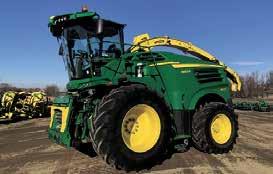

Another example is what we do with cows diagnosed open on herd check day. There should be a very well-dened protocol.
For example: Cows with a corpus luteum greater than 1.5 cm receive GnRH and are enrolled in an ovsynch protocol. Cows without a corpus luteum greater than 1.5 cm receive GnRH and a CIDR and are enrolled in an ovsynch protocol.




However, sometimes we cannot help ourselves and want to do something different to an open cow. Maybe she is someone’s favorite cow. Maybe someone thought they might have seen her in heat last weekend. Maybe she is kind of thin. Maybe it depends on who is holding the clipboard. So, we decide, right
on the spot, based entirely on that one brief ultrasound exam to pull her from the protocol and do something different. We give her prostaglandin. After that, hopefully someone sees her in heat and breeds her.
We should not do this without a compelling reason. For example, maybe the cow is so lame and so thin there is good reason to believe she will not ovulate. But, there should only be a tiny percentage of cows that are taken out of the protocol for compelling reasons. It is not only farmers; sometimes veterinarians like to pull cows from the protocol, too, for reasons we think are compelling when they are not compelling enough.
Often, when farmers or veterinarians deviate from the protocol, it is done based on experience. However, pregnancy after A.I. is a binomial outcome, meaning yes or no. When we judge success based on binomial results, we need a ton of observations to know if the difference is real and not just chance. So the “Tried that here; it didn’t work” thinking needs to be based on hundreds of breedings, maybe even thousands. Only a tiny minority of farms are large enough to have enough breedings in a reasonable amount of time to make correct decisions. That is why we rely on research and, to some degree, veterinary experience with lots and lots of cows. Research on thousands of cows tells us, for example, that a second injection of prostaglandin in the second part of the double ovsynch protocol will signicantly increase conception rates in second lactation and older cows. Such research and experience are used to de-
velop protocols. Our job is to choose the best protocol for the farm and then to work within it. Over time, we might observe results that are not what we expected. In those cases, we then can ask, are we doing the protocol correctly, or is our protocol not the right protocol for us? If we are pulling a signicant number of cows out of the protocol, we really do not know what we are actually doing and cannot answer those two questions. Thus, we can only succeed by chance instead of by design.
The key is to be smart about designing and implementing the protocol and then stick with it. Clients in our veterinary practice in southeast Minnesota, on average, have been increasing herd pregnancy rates by about 1 point per year for nearly the last 20 years. Much of this increase is due to proper use of well-designed reproductive protocols. There are about 45,000 dairy cows in our practice. Using a net value of $15 per cow per point of pregnancy rate per year, the total increase in value to the community of our practice’s clients would be $675,000 per year. Protocols work not just for mixing feed or milking cows but also for getting cows pregnant. Sticking with the protocol should be just how we do it here.
Bennett is one of four dairy veterinarians at Northern Valley Dairy Production Medicine Center in Plainview, Minnesota. He also consults on dairy farms in other states. He and his wife, Pam, have four children. Jim can be reached at bennettnvac@gmail.com with comments or questions.

Who owns the water?
This has been an interesting month in our small town of Elko New Market, Minnesota.We are located 30 minutes south of Minneapolis on Interstate 35. To call it a small town is a bit of a stretch, or at least it feels that way if you lived here when it was a farming community of 250 people before it became a suburb with a population around 3,000.
Either way, small town is how the residents view our community. Every time a new project or development in the town is brought up for approval by the city council, the civically minded assess and argue whether the change will cause the town to stop feeling small. I suppose the day people quit caring about what happens in the town as a whole and worry about their specic neighborhood is when it has lost the small-town feel, but it seems we’re safe for now as
A little over a month ago, members of the community found out a local developer submitted a proposal for a large water bottling plant. If approved, it will be the rst industrial business to be sited in the area that has been theoretically the town’s industrial park for a couple decades.
Due to the way these things are handled, many people in town felt rather taken off guard to not know about the plans until only a little over a month before the city council either approves the permit or it is automatically approved at the 60-day limit.
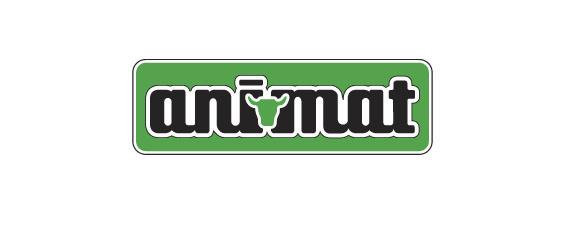

I say the town has to approve or it will automatically be approved because there aren’t that many boxes to check in this town to meet the minimal criteria to build here, and the developer and bottling company have checked them all.




Some people are upset because it will be built by their homes, some are concerned about the effect of plastic bottles on the environment, some people don’t want any more trafc on our inadequate freeway interchange, and others, myself included, are concerned about the effects of tripling the draw on the local aquifer with one business.
From the Zweber FarmMinnesota is the Land of 10,000 Lakes and a whole lot of swamps, rivers and streams to boot. Obviously, we aren’t like the West where the access to water that comes with land purchases is often more valuable than the land itself. That said, water is a resource that, while renewable, is not innitely extractible without consequences. When people resettled this area – I say resettled because if we’re being honest the Native Americans settled it before us – there was a seemingly endless supply of trees which took considerably less time than expected to log off. The trees are growing back and aquifers rell, but the process, like seemingly all natural processes, takes time.
Our family has joined with a large number of people in the township and city to express our concerns with allowing a company based in California to move in and prot off of bottling a resource we all depend on.
It’s been an interesting experience in civic engagement and grassroots organization that I’ve not seen in our town before. Through a lot of conversations with people around this topic, I have continually bumped on the question of who owns the water all around us and how to value that resource.

The water gets to the aquifer by ltering down through the soil. Farmers are the biggest owners of the land which provides that ecological service, yet beyond using the water for irrigation in some areas,

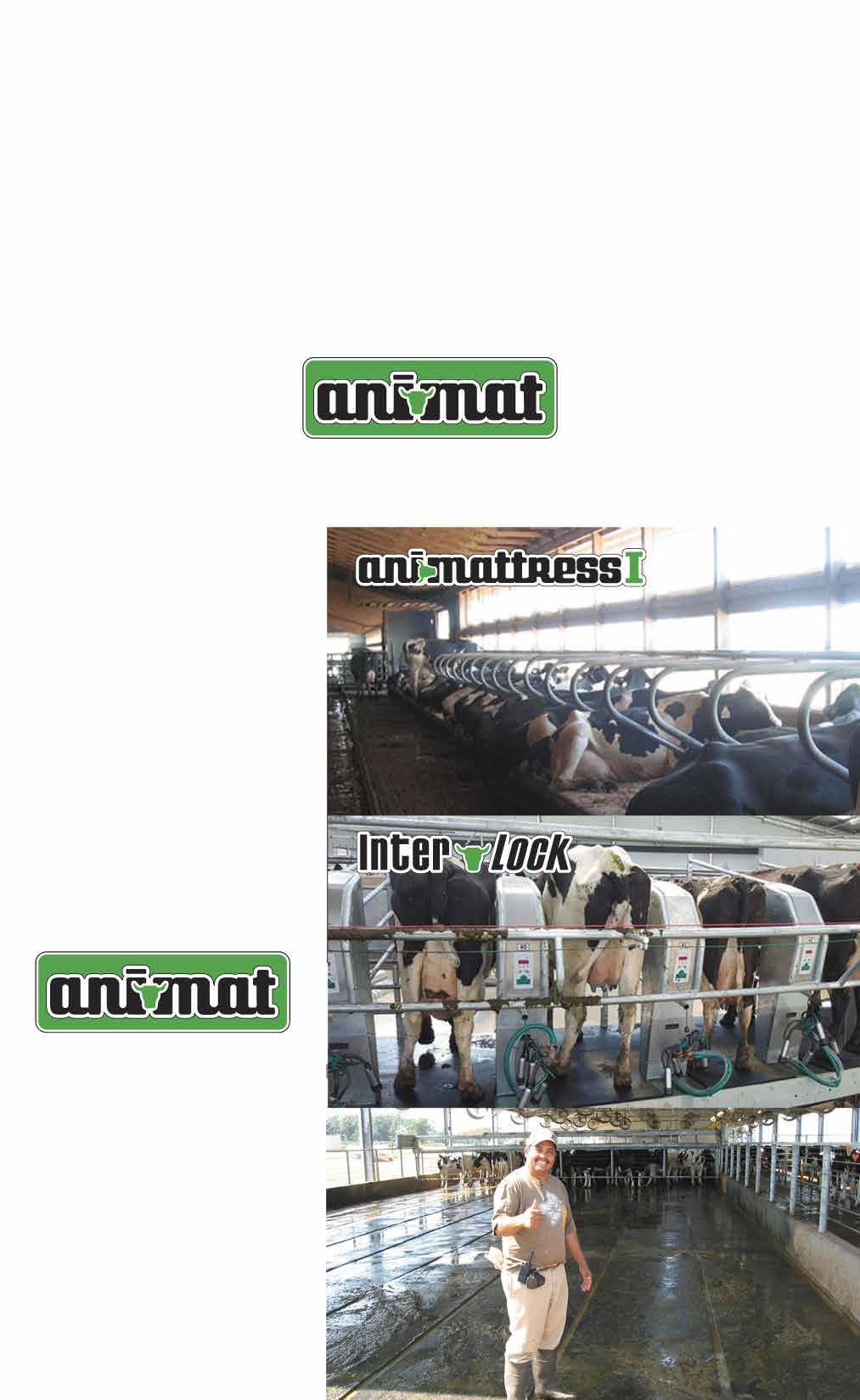
It’s been an interesting experience in civic engagement and grassroots organization that I’ve not seen in our town before.
we don’t prot off that service. The Department of Natural Resources issues the permits that allow people to pump from the aquifer, so I guess one could say the government owns it; although other than stopping people from drawing too much water in an area, they don’t stop anyone from utilizing the resource. I have yet to come up with an answer and maybe never will. Hopefully it won’t matter, but looking West, I have my doubts.

Time to nish this coffee and get back outside to haul some manure and feed cows. Until next time, keep living the dream and maybe take advantage of all that water we have around here by doing a little ice shing. I hear it is good relaxation to sit and stare at a hole waiting for a bobber to move. Then again, maybe it’s just the beer everyone brings with them.
Tim Zweber farms with his wife, Emily, their three children and his parents, Jon and Lisa, near Elko, Minnesota.
The month of December can be a good time for reection. I am inclined to think about where I have been and what is ahead as I go about taking care of the livestock and people in my life.

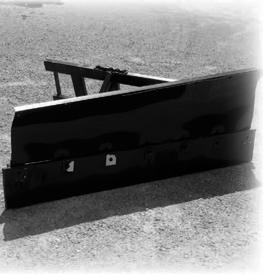
It is appropriate in this month’s column to reect with readers, because it will be my nal one. I have decided it is time to switch my focus to other tasks and demands on my time on our dairy farm and in life. I have loved and will miss this monthly sharing of thoughts and ideas with all of you. I consider you my friends and folks who are likeminded in our enthusiasm for all things dairy.
Writing this column has been a stretch for me in my journalism career. Prior to this, I had only written stories to report on the ideas, achievements, challenges, works and words of others who either dairy farm or who advise those who operate dairies. I know I have also employed that technique in my column by sharing information gleaned from others when it seemed relevant to what was happening on our dairy farm or with the challenges we all face as dairy farmers.
Besides pulling information from other talented and intelligent helpers, I have always tried to sprinkle personal information about our farm, the people who work with the cattle and crops, including my own family members, into my column. I hope that all of you who read my words from time to time have enjoyed learning about Annexstad Dairy Farms. Perhaps reading about some of our specic trials, achievements and everyday tasks has shown that we all encounter many of the same challenges on our dairy farms. As peers in this business, we can all benet and build on each other’s successes when we are aware of what we face.
It is easy to get mired down in the time and energy it will take to meet the demands of running our dairy farm well into the future. We will personally need to decide many things if the next generation wants to continue with our dairy. This will take multiple conversations with advisors to seek information and the best course. It will require ambition and the drive to move forward. And, it will take paperwork, which is not the favorite task of any farmer I know.
We have started this process, but there is much left to do. In the midst of manure hauling, milking, feeding and all of the other tasks, nding the time to nalize a plan is a challenge. We need to rely on others to help us. It will take intelligence from advisors, helpers and experts to join with us to get a plan nailed down, nanced and implemented. Fortunately, our industry has many people who are poised and willing to help.
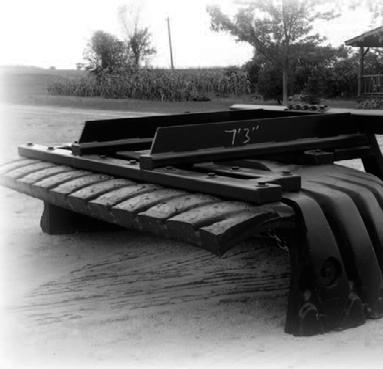
Seek out the helpers and remain positive.
That will be our mantra as we move forward with our barn renovation, manure system changes and make transitions to technology for milking and cow management. It is likely good advice for all aspects of farming and life.
On a more personal note, our family has much to look forward to. Our three adult kids have each launched careers in agriculture after obtaining their college degrees. After an internship at a large Wisconsin dairy, Matthias has decided to farm with us as he ponders his options for employment or further education. Leif has begun as a genetic and reproductive advisor for Minnesota Select Sires, and Emily is marketing and communications manager for Holstein Association USA. All three are immersed in their careers; it is fun to witness how they use their knowledge and student experiences to help others in the dairy business and to aid us with our plans.
We are excited to gain a new son when Emily marries Anthony Bosch in July 2023. Anthony brings many talents and skills to our family. He is a skilled mechanic (My xer list is always ready for his visits.) and works as a precision ag specialist at a John Deere dealership.
Their wedding will be fun to plan and implement in the coming year and most certainly a family event to remember.
I look forward to the next column writer’s words of wisdom, knowledge and encouragement. I have been an avid reader all of my life and will continue seeking the help and positive thoughts of others to propel me on my life path.
Thank you, Dairy Star readers, for taking time to read my words. I hope I have given you something to ponder, wonder or maybe smile about with this column.
All the best to each of you and blessings for the Christmas season as you celebrate and remember the manger where love came to Earth in a humble stable.
Jean dairy farms with her husband, Rolf, and brother-in-law, Mike, and children Emily, Matthias and Leif. They farm near St. Peter, Minnesota, in Norseland, where she is still trying to t in with the Norwegians and Swedes. They milk 200 cows and farm 650 acres. She can be reached at jeanannexstad@ gmail.com.





The RECAL line of probio cs is NOT just another probio c on the market. RECAL is a probio c heavily weighted towards be er diges on and u liza on, primarily FIBER DIGESTION. There are a lot of nutrients in your forages that can be u lized by improving diges on.
RECAL is also a probio c that produces more B-vitamins in the rumen of that cow, mainly vitamin B12. B-vitamins are well known to aide in s mula ng appe te, stress, immune system, reproduc on and also very important in rumen diges on.
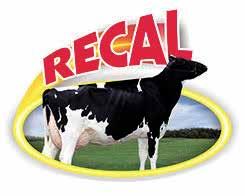
In March of 2021 a friend of mine told me that he was using and really liked the RECAL probio c and that I should check into it. I wasn’t having any issues but I was seeing a fair amount of corn passing through the cows. I asked my nutri onist about it and he said that products like that don’t do any good and that it would be a waste of money. I decided to go ahead and call Jamie Troxel about the RECAL anyhow as I had been seeing his adver sements. We talked on the phone and Jamie said he was going to be in my area that next week, so I told him to stop in.

Jamie came to my farm and looked at my diet, saying that he doesn’t want to change anything, he just wants to see what type of diet I was feeding. He looked at the feed, the cows, and the manure, and asked some ques ons about the herd and where produc on was at. He then talked about the RECAL Probio c and the three di erent products that he has to o er to feed on a daily basis. He then o ered me a free 30-day trial and explained how that worked. I thought what the heck, I don’t have anything to lose so I took him up on the o er.
Jamie will tell you it is not all about milk produc on. It is the li le things!!! If you don’t get the li le things right you aren’t going to get higher produc on and be more pro table. He will also tell you that the RECAL isn’t for just herds with issues, it can improve all herds but not all herds see the same results, every farm is di erent. Since I was seeing a fair amount of corn passing through the cows, he recommended I start with RECAL Plus SS. He showed me how to feed it and told me what to watch for. The cows don’t lie but you need to know what to be looking for.

When I started the RECAL Plus SS the manure was consistent but s and had a fair amount of corn and ber showing. Milk produc on was hanging right about 81#, 4.00% BF, 3.10% Pro, 12 MUN, 100,000 SCC. Within three days I could see a di erence in the manure. It was ge ng creamier and a few days a er that I could see that there was less corn and ber in the manure. I did gain about three pounds of milk about a week a er star ng the RECAL. I was seeing stronger heats too and I was extremely happy with what I was seeing in the cows. Since then, I have switched to feeding just the RECAL Plus.
I milk about 80 cows near Quarryville, PA and I highly recommend every dairyman call Jamie and try the RECAL Probio cs even if your nutrionist tells you otherwise. With the 30-day trial he o ers, what do you have to lose????
As a dairyman, are you looking to improve the way your fresh cows transition, take off, peak and breed back? Looking to improve rumen health, rumen function, overall health, digestion, feed efficiency, and YOUR BOTTOM LINE??? If so, then…
The GEA Magnum LPS low profile vertical lift parlor stalls are designed for quick installation and fast facility upgrades.
Contact Your Local GEA Milking Equipment Dealer:

Central Ag Supply, Inc.
Centre Dairy Equipment and Supply Inc.
Sauk Centre, MN 320-352-5762 • 800-342-2697
Centre Dairy Equipment and Supply Inc.
Sauk Centre, MN
Fuller’s Milker Center, LLC
Leedstone, Inc. Melrose, MN
Glencoe, MN
Lancaster, WI • 800-887-4634 Richland Center, WI • 608-647-4488
Leedstone, Inc. Melrose, MN 320-256-3303 • 800-996-3303 Glencoe, MN 320-864-5575 • 877-864-5575 Plainview, MN • 800-548-5240 Menomonie, WI • 715.231.8090
Sioux Dairy Equipment, Inc.
Sioux Dairy Equipment, Inc. Rock Valley, IA
Rock Valley, IA 712-476-5608 • 800-962-4346
Colton, SD Service 800-944-1217 Edgerton, MN Chemical Sales 507-920-8626
J Gile Dairy Equipment

Cuba City, WI • (608) 744-2661
Kozlovsky Dairy Equipment Kaukauna, WI •920-759-9223 Weston, WI • 715-298-6256
Stanley Schmitz, Inc.
Fuller’s Milker Center, Inc.
Midwest Livestock Systems, LLC
Central Ag Supply Inc.
J Gile Dairy Equipment, Inc.
Midwest Livestock Systems, LLC Zumbrota, MN • 800-233-8937 Menomonie, WI • 715-235-5144 Renner, SD • 800-705-1447
Kozlovsky Dairy Equipment
Monroe WestfaliaSurge Monroe, WI • 608-325-2772
Preston Dairy Equipment Sparta, WI • (608) 269-3830
Juneau, WI • 920-386-2611 Baraboo, WI • 608-356-8384
Monroe Westfalia Surge
Stanley Schmitz, Inc. Chilton, WI • 920-849-4209
Tri-County Dairy Supply
Eastern Iowa Dairy Systems Epworth, IA • (563) 876-3087
Preston Dairy Equipment
Tri-County Dairy Supply Janesville, WI • (608) 757-2697